

What Is A Warrant In Writing? (Explained + 20 Examples)
Ever wondered how writers make their claims stick?
That’s where warrants come in, bridging the gap between evidence and conclusion.
What is a warrant in writing?
A warrant in writing connects a claim to evidence, serving as the underlying logic, ethical principle, or emotional appeal that makes an argument persuasive. It’s the bridge that ensures an argument’s coherence and strength.
In this guide, you’ll learn everything you need to know about warrants in writing.
What Is a Warrant in Writing (Long Explanation)?

Table of Contents
When we talk about a warrant in writing, we’re diving into the backbone of persuasive and argumentative writing.
It’s not the flashy evidence or the bold claim that gets the spotlight.
Rather, it’s the unsung hero that connects the two, ensuring your argument stands strong and coherent.
Through trial and error, I’ve learned that a well-crafted warrant can turn a skeptical reader into a believer, highlighting the nuanced art of persuasion that goes beyond mere facts.
Imagine you’re building a bridge.
Your claim is on one side, your evidence on the other, and the warrant is what lies beneath, holding it all together.
It answers the silent question of “Why does this evidence support my claim?” without which your argument might just fall into the water.
Warrants are based on logic, ethics, or emotions, tailored to your audience’s beliefs and values.
They’re not always explicitly stated but are crucial for the argument’s acceptability.
Think of them as the glue that binds your argument, making it not just a collection of statements but a coherent, persuasive message.
Types of Warrants in Writing (10 Types)
Warrants come in various forms, each serving a unique purpose in strengthening your argument.
Let’s explore the ten types of warrants that can transform your writing:
- Logical Warrants – These are grounded in logic, appealing to the reader’s sense of reason.
- Ethical Warrants – These appeal to the reader’s sense of morality and ethics.
- Emotional Warrants – Aimed at stirring the reader’s emotions.
- Authoritative Warrants – Rely on the credibility of the source or author.
- Analogical Warrants – Use analogies to draw parallels between concepts.
- Causal Warrants – Establish a cause-effect relationship.
- Generalization Warrants – Apply a general principle to a specific case.
- Sign Warrants – Use signs or indicators as evidence for the claim.
- Analogy Warrants – Similar to analogical but often use metaphors or similes for comparison.
- Statistical Warrants – Use statistics and numerical data to support the claim.
Understanding these types is crucial for effectively incorporating warrants into your writing, ensuring your arguments are not only heard but resonate with your audience.
20 Examples of Warrants in Writing
Before we dive into the examples, it’s essential to grasp the significance of each warrant type.
By understanding and applying these warrants, you can enhance the persuasiveness of your writing, making your arguments more compelling and impactful.
Logical Warrants: The Bridge of Reason
Imagine arguing that a well-balanced diet improves academic performance.
The logical warrant here connects the nutritional benefits of a balanced diet to enhanced brain function and, consequently, better academic outcomes.
It’s the reasoning that if your body gets the right nutrients, your brain operates more efficiently.
And that leads to improved academic performance.
Ethical Warrants: The Moral Compass
Consider the claim that companies should adopt more sustainable practices.
The ethical warrant appeals to the moral obligation of preserving the environment for future generations.
It’s the understanding that, as stewards of the planet, companies have a moral duty to minimize environmental harm, making the argument not just logical but morally compelling.
Emotional Warrants: The Heart’s Argument
Take the argument that animal shelters should receive more funding.
The emotional warrant plays on the audience’s compassion for animals, linking the plight of shelter animals to the emotional response of the audience.
It’s the heart-tugging connection that motivates action, not just through logic but through feeling.
Authoritative Warrants: The Voice of Credibility
Arguing that vaccinations are safe and effective might draw on authoritative warrants.
This warrant relies on the credibility of medical institutions and experts, asserting that if trusted sources endorse vaccinations, they must be safe and beneficial.
It’s the trust in authority that bolsters the argument’s weight.
Analogical Warrants: Connecting Dots with Similarity
If arguing for the importance of cybersecurity measures in small businesses, you might use an analogical warrant comparing cyber threats to burglaries.
This analogy highlights the necessity of protective measures, both physical and digital, to safeguard valuable assets.
Analogical warrants make the argument relatable and understandable.
Causal Warrants: Cause and Effect
In arguing that excessive screen time leads to poor sleep patterns, the causal warrant establishes a cause-effect relationship between screen time and sleep quality.
It’s the logical link that prolonged exposure to screens before bedtime disrupts sleep.
Casual warrants ground the argument in a cause-and-effect reality.
Generalization Warrants: The Broad Stroke
When claiming that reading enhances empathy, a generalization warrant might apply the broad principle that exposure to diverse perspectives through literature broadens one’s understanding and acceptance of different life experiences.
This warrant generalizes the benefit of reading to a wider application.
It suggests that engaging with a variety of characters and stories inherently fosters empathy among readers.
Sign Warrants: Reading the Signs
Consider the argument that a thriving local arts scene indicates a city’s economic health.
The sign warrant here uses the vibrancy of the arts community as an indicator or sign of broader economic prosperity.
It’s the interpretation of thriving cultural initiatives as evidence of sufficient disposable income and investment in community well-being, linking cultural vibrancy to economic health.
Analogy Warrants: Seeing in a New Light
In advocating for renewable energy sources, an analogy warrant might compare the transition from fossil fuels to renewables to upgrading from an old, inefficient car to a modern, fuel-efficient model.
This analogy makes the concept more accessible and relatable.
Analogy warrants illustrate the benefits of modernization and efficiency in energy sources through a familiar scenario.
Statistical Warrants: The Power of Numbers
This warrant leans on numerical data to substantiate the claim.
Arguing for the effectiveness of a new teaching method, a statistical warrant could highlight improved test scores in classes where the method was implemented.
These warrants offers concrete evidence that the new teaching approach leads to better academic outcomes.
Generalization Warrants: The Universal Principle
The warrant suggests that the benefits observed in the past are likely to recur under similar systems.
When arguing that democracy is the most effective form of government, a generalization warrant might draw from historical examples where democratic systems led to prosperous and stable societies.
This warrant applies the broad principle that, given the success of democracy across various contexts and times, it can be considered the best form of governance.
It’s a leap from specific historical instances to a universal conclusion.
Sign Warrants: The Indicator
In the debate over economic policies, one might claim that low unemployment rates signal a healthy economy.
The sign warrant here interprets low unemployment as an indicator of economic strength, suggesting that when more people are employed, it reflects well on the economic policies in place.
This warrant relies on the observable condition (employment rates) as a sign of broader economic health.
It makes a case for the effectiveness of current policies.
Analogy Warrants: Visual Metaphors
Advocating for regular breaks from digital devices, an analogy warrant could compare digital consumption to eating junk food.
For example, just as the latter requires moderation to maintain physical health, the former needs limits to preserve mental well-being.
This analogy helps audiences understand the concept of digital detox by relating it to a familiar practice of dietary moderation, enhancing the argument’s relatability and persuasiveness.
Statistical Warrants: Facts and Figures
This approach uses hard numbers to demonstrate the direct consequences of inaction.
Presenting an argument for urgent action on climate change, a statistical warrant might utilize data showing rising global temperatures and increasing frequency of natural disasters.
It aims to convince skeptics through undeniable evidence that climate change is not only real but also an immediate threat.
Logical Warrants: Deductive Reasoning
This warrant connects the dots between individual immunization and community health benefits.
In discussions about public health, arguing that vaccinations prevent widespread outbreaks relies on the logical warrant that vaccines build herd immunity, making it harder for diseases to spread.
Logical warrants employ deductive reasoning to make a case for widespread vaccination programs.
Ethical Warrants: The Right Thing to Do
Arguing for equal access to education, the ethical warrant might stem from the belief that education is a fundamental human right.
This warrant appeals to the sense of fairness and justice, positing that denying anyone access to education is morally wrong.
It’s an argument built on the ethical principle that equality in education is not just beneficial but a moral imperative.
Emotional Warrants: Pathos in Play
When making a case for conservation efforts, an emotional warrant could highlight the plight of endangered species facing extinction.
By evoking empathy for these animals, the warrant seeks to motivate action based on emotional response.
You can leverage the power of pathos to make the argument for conservation not just logical but emotionally compelling.
In my own writing, I’ve discovered that the most compelling arguments are those where the warrant is implicitly understood, yet powerfully resonant with the audience’s core beliefs.
Authoritative Warrants: Expert Endorsements
In advocating for a new health guideline, using authoritative warrants involves citing recommendations from health organizations or experts.
This type of warrant leans on the credibility and expertise of authorities in the field.
The warrant suggests that if such entities endorse a guideline, it is based on solid research and should be followed.
It’s an appeal to authority that lends weight to the argument through expert endorsement.
Causal Warrants: Tracing Effects to Causes
Arguing that social media can result in more loneliness and isolation, a causal warrant examines the effect (loneliness) and traces it back to its cause (social media usage).
This warrant establishes a direct link between the cause and effect.
Casual warrants offer a logical explanation for how too much social media exposure can disrupt and decrease your mental health.
Analogical Warrants: Bridging Concepts
In discussions about governance and policy, comparing the state to a ship and its government to the crew provides an analogical warrant that governance requires cooperation and direction, much like navigating a ship.
This analogy helps illustrate the complexity of governance and the importance of unified direction and teamwork.
Analogical warrants make the argument more accessible and understandable through the comparison.
Here is a good video about warrants in writing:
Final Thoughts: What Is a Warrant in Writing?
Understanding warrants is key to unlocking the full potential of your arguments.
Reflecting on my writing journey, I’ve come to appreciate that mastering the use of warrants is akin to fine-tuning a musical instrument—it’s delicate, requires practice, and when done right, makes your argument sing.
Read This Next:
- 50 Best Counterclaim Transition Words (+ Examples)
- What Is A Personal Account In Writing? (47 Examples)
- What Is A Lens In Writing? (The Ultimate Guide)
- What Is On-Demand Writing? (Explained with Examples
Argumentation and Persuasion
Sometimes an argument needs further reinforcement through the use of what is known as a warrant, which is an underlying belief that connects a reason and the claim. Usually it is unnecessary to include warrants in an argument since the audience will generally also hold those beliefs, but there are occasions when they are critical to use, such as:
- If the audience is outside of the discourse community, so it is not (as) familiar with the topic and needs additional information;
- If the reason is a new way of thinking or is heavily debated; and
- If the audience is likely to be (highly) resistant to the reason.
Including a warrant when any of these apply can make the difference between whether the argument is successful or unsuccessful.
Take, for example, the following paragraph, written to support the claim that bullying should be collaboratively addressed by educators, parents, and those who experience bullying:
When an adolescent is bullied, he/she often undergoes behavioral and emotional changes, changes that can pose significant harm to him/her as well as others. For example, sometimes the young person who is bullied will abuse substances in order to cope with what he/she is going through, as Litwiller and Brausch (2013) explain: “Several painful and provocative behaviors have been identified consistently as behaviors that relate to both bullying and adolescent suicidal behavior. Of all such risk behaviors, alcohol and/or illicit drug use has most frequently been shown to relate” (p. 676.). If these behaviors go unnoticed, then the person being bullied is likely to continue engaging in the alcohol and/or drug use, which can lead to further consequences for him/her as well as others. Hinduja and Patchin (2013) explain that “bullying (offline and online) has been tied to a host of other negative psychosocial and behavioral outcomes such as suicidal ideation, dropping out of school, aggression and fighting…and carrying a weapon to school” (p. 712). All of these outcomes affect not only the individual being bullied, but also those around him/her, with the potential for violence to occur in the school setting. Ignoring the effects of bullying is not an option, then, and bullying must be addressed by all parties involved.
In the paragraph, the first sentence is the topic sentence, which establishes a reason to support the claim and prepares the reader for the content that will appear in the paragraph. The next sentence then offers an example of the changes the topic sentence refers to, leading into the third sentence that integrates source material to show that substance abuse is indeed one of the behavioral changes that occur. At this point in the paragraph, we have been provided a reason to support the claim as well as evidence that supports the reason, and as the paragraph continues we are given additional examples and source material to demonstrate why the reason is a sound reason to support the claim. The paragraph then concludes by reinforcing the claim, asserting that the harm these changes present to the person who is bullied as well as others makes it critical for all relevant parties to address bullying. Presumably, for most readers, the paragraph represents a clear chain of reasoning, because if bullying presents a threat to the person who is bullied as well as those around him/her, then it is sensible to claim that the bullying should be stopped; further, since in many cases the bullied will be unable to end the abuse himself/herself, it is necessary for others in positions of power to step in.
However, some readers may not think that just because there are potential consequences of bullying for the bullied as well as those around him/her that educators, parents, and the bullied should work together to end the bullying. Instead, some readers may think that stopping bullying is the responsibility of educators and/or parents alone since adolescents are not in the same position of power as these other parties, and the bullying may only escalate if the bullied try to end it. Others may think that, depending on how the bullying is occurring (such as if it is limited to online bullying outside of school grounds) that it is beyond the scope and power of educators to step in, leaving the burden for parents and/or their children who are experiencing the bullying. For these readers then, a warrant would be necessary to demonstrate why the reason clearly supports the claim; otherwise, they would be unpersuaded by this part of the argument—and possibly the argument overall, depending on how central the reason was to supporting the claim.
Thus, when developing your argument you must keep in mind that its structure is sort of like the structure of a building. There are certain parts that are essential (i.e., the claim, reasons, and evidence, just like the foundation, walls, and entry/exit routes), whereas other parts may be useful, but are not always needed (i.e., counterarguments, acknowledgment and response, and warrants, just like upgrades such as heated flooring).
- Counterarguments, Acknowledgement and Response, and Warrants. Authored by : Karla Lyles and Jeanine Rauch. Provided by : University of Mississippi. Project : WRIT 250 Committee OER Project. License : CC BY-SA: Attribution-ShareAlike

Privacy Policy
Purdue Online Writing Lab Purdue OWL® College of Liberal Arts
Organizing Your Argument

Welcome to the Purdue OWL
This page is brought to you by the OWL at Purdue University. When printing this page, you must include the entire legal notice.
Copyright ©1995-2018 by The Writing Lab & The OWL at Purdue and Purdue University. All rights reserved. This material may not be published, reproduced, broadcast, rewritten, or redistributed without permission. Use of this site constitutes acceptance of our terms and conditions of fair use.
How can I effectively present my argument?
In order for your argument to be persuasive, it must use an organizational structure that the audience perceives as both logical and easy to parse. Three argumentative methods —the Toulmin Method , Classical Method , and Rogerian Method — give guidance for how to organize the points in an argument.
Note that these are only three of the most popular models for organizing an argument. Alternatives exist. Be sure to consult your instructor and/or defer to your assignment’s directions if you’re unsure which to use (if any).
Toulmin Method
The Toulmin Method is a formula that allows writers to build a sturdy logical foundation for their arguments. First proposed by author Stephen Toulmin in The Uses of Argument (1958), the Toulmin Method emphasizes building a thorough support structure for each of an argument's key claims.
The basic format for the Toulmin Method is as follows:
Claim: In this section, you explain your overall thesis on the subject. In other words, you make your main argument.
Data (Grounds): You should use evidence to support the claim. In other words, provide the reader with facts that prove your argument is strong.
Warrant (Bridge): In this section, you explain why or how your data supports the claim. As a result, the underlying assumption that you build your argument on is grounded in reason.
Backing (Foundation): Here, you provide any additional logic or reasoning that may be necessary to support the warrant.
Counterclaim: You should anticipate a counterclaim that negates the main points in your argument. Don't avoid arguments that oppose your own. Instead, become familiar with the opposing perspective. If you respond to counterclaims, you appear unbiased (and, therefore, you earn the respect of your readers). You may even want to include several counterclaims to show that you have thoroughly researched the topic.
Rebuttal: In this section, you incorporate your own evidence that disagrees with the counterclaim. It is essential to include a thorough warrant or bridge to strengthen your essay’s argument. If you present data to your audience without explaining how it supports your thesis, your readers may not make a connection between the two, or they may draw different conclusions.
Example of the Toulmin Method:
Claim: Hybrid cars are an effective strategy to fight pollution.
Data1: Driving a private car is a typical citizen's most air-polluting activity.
Warrant 1: Due to the fact that cars are the largest source of private (as opposed to industrial) air pollution, switching to hybrid cars should have an impact on fighting pollution.
Data 2: Each vehicle produced is going to stay on the road for roughly 12 to 15 years.
Warrant 2: Cars generally have a long lifespan, meaning that the decision to switch to a hybrid car will make a long-term impact on pollution levels.
Data 3: Hybrid cars combine a gasoline engine with a battery-powered electric motor.
Warrant 3: The combination of these technologies produces less pollution.
Counterclaim: Instead of focusing on cars, which still encourages an inefficient culture of driving even as it cuts down on pollution, the nation should focus on building and encouraging the use of mass transit systems.
Rebuttal: While mass transit is an idea that should be encouraged, it is not feasible in many rural and suburban areas, or for people who must commute to work. Thus, hybrid cars are a better solution for much of the nation's population.
Rogerian Method
The Rogerian Method (named for, but not developed by, influential American psychotherapist Carl R. Rogers) is a popular method for controversial issues. This strategy seeks to find a common ground between parties by making the audience understand perspectives that stretch beyond (or even run counter to) the writer’s position. Moreso than other methods, it places an emphasis on reiterating an opponent's argument to his or her satisfaction. The persuasive power of the Rogerian Method lies in its ability to define the terms of the argument in such a way that:
- your position seems like a reasonable compromise.
- you seem compassionate and empathetic.
The basic format of the Rogerian Method is as follows:
Introduction: Introduce the issue to the audience, striving to remain as objective as possible.
Opposing View : Explain the other side’s position in an unbiased way. When you discuss the counterargument without judgement, the opposing side can see how you do not directly dismiss perspectives which conflict with your stance.
Statement of Validity (Understanding): This section discusses how you acknowledge how the other side’s points can be valid under certain circumstances. You identify how and why their perspective makes sense in a specific context, but still present your own argument.
Statement of Your Position: By this point, you have demonstrated that you understand the other side’s viewpoint. In this section, you explain your own stance.
Statement of Contexts : Explore scenarios in which your position has merit. When you explain how your argument is most appropriate for certain contexts, the reader can recognize that you acknowledge the multiple ways to view the complex issue.
Statement of Benefits: You should conclude by explaining to the opposing side why they would benefit from accepting your position. By explaining the advantages of your argument, you close on a positive note without completely dismissing the other side’s perspective.
Example of the Rogerian Method:
Introduction: The issue of whether children should wear school uniforms is subject to some debate.
Opposing View: Some parents think that requiring children to wear uniforms is best.
Statement of Validity (Understanding): Those parents who support uniforms argue that, when all students wear the same uniform, the students can develop a unified sense of school pride and inclusiveness.
Statement of Your Position : Students should not be required to wear school uniforms. Mandatory uniforms would forbid choices that allow students to be creative and express themselves through clothing.
Statement of Contexts: However, even if uniforms might hypothetically promote inclusivity, in most real-life contexts, administrators can use uniform policies to enforce conformity. Students should have the option to explore their identity through clothing without the fear of being ostracized.
Statement of Benefits: Though both sides seek to promote students' best interests, students should not be required to wear school uniforms. By giving students freedom over their choice, students can explore their self-identity by choosing how to present themselves to their peers.
Classical Method
The Classical Method of structuring an argument is another common way to organize your points. Originally devised by the Greek philosopher Aristotle (and then later developed by Roman thinkers like Cicero and Quintilian), classical arguments tend to focus on issues of definition and the careful application of evidence. Thus, the underlying assumption of classical argumentation is that, when all parties understand the issue perfectly, the correct course of action will be clear.
The basic format of the Classical Method is as follows:
Introduction (Exordium): Introduce the issue and explain its significance. You should also establish your credibility and the topic’s legitimacy.
Statement of Background (Narratio): Present vital contextual or historical information to the audience to further their understanding of the issue. By doing so, you provide the reader with a working knowledge about the topic independent of your own stance.
Proposition (Propositio): After you provide the reader with contextual knowledge, you are ready to state your claims which relate to the information you have provided previously. This section outlines your major points for the reader.
Proof (Confirmatio): You should explain your reasons and evidence to the reader. Be sure to thoroughly justify your reasons. In this section, if necessary, you can provide supplementary evidence and subpoints.
Refutation (Refuatio): In this section, you address anticipated counterarguments that disagree with your thesis. Though you acknowledge the other side’s perspective, it is important to prove why your stance is more logical.
Conclusion (Peroratio): You should summarize your main points. The conclusion also caters to the reader’s emotions and values. The use of pathos here makes the reader more inclined to consider your argument.
Example of the Classical Method:
Introduction (Exordium): Millions of workers are paid a set hourly wage nationwide. The federal minimum wage is standardized to protect workers from being paid too little. Research points to many viewpoints on how much to pay these workers. Some families cannot afford to support their households on the current wages provided for performing a minimum wage job .
Statement of Background (Narratio): Currently, millions of American workers struggle to make ends meet on a minimum wage. This puts a strain on workers’ personal and professional lives. Some work multiple jobs to provide for their families.
Proposition (Propositio): The current federal minimum wage should be increased to better accommodate millions of overworked Americans. By raising the minimum wage, workers can spend more time cultivating their livelihoods.
Proof (Confirmatio): According to the United States Department of Labor, 80.4 million Americans work for an hourly wage, but nearly 1.3 million receive wages less than the federal minimum. The pay raise will alleviate the stress of these workers. Their lives would benefit from this raise because it affects multiple areas of their lives.
Refutation (Refuatio): There is some evidence that raising the federal wage might increase the cost of living. However, other evidence contradicts this or suggests that the increase would not be great. Additionally, worries about a cost of living increase must be balanced with the benefits of providing necessary funds to millions of hardworking Americans.
Conclusion (Peroratio): If the federal minimum wage was raised, many workers could alleviate some of their financial burdens. As a result, their emotional wellbeing would improve overall. Though some argue that the cost of living could increase, the benefits outweigh the potential drawbacks.

Writing Nestling

What Is A Warrant In Writing? (Explained+ 4 Types)
In the intricate tapestry of persuasive writing, warrants emerge as the linchpins that bridge the gap between evidence and claim, lending credibility and coherence to arguments.
Simply put, a warrant in writing acts as the logical connection or reasoning that links the evidence presented to the assertion or claim being made. It serves as the underlying justification or principle that allows readers to accept the leap from data to conclusion.
As such, warrants play a pivotal role in crafting convincing arguments, guiding readers through the intricacies of reasoning and persuasion.
However, warrants are not always explicitly stated; they can be implicit, implied through context or inferred from the structure of the argument.
Understanding the nuances of warrants is essential for effective communication and critical thinking, as they underpin the foundation of logical discourse in various fields, from academia to law to everyday rhetoric.
In this exploration, we delve into the multifaceted nature of warrants in writing, dissecting their forms, functions, and applications across diverse contexts to illuminate their significance in shaping our understanding and interpretation of the world around us.
Table of Contents
What Is A Warrant In Writing?
A warrant in writing is a legal document that authorizes or empowers a person or entity to perform certain actions or make specific decisions.
Identification of Parties
It typically involves at least two parties: the issuer of the warrant and the recipient or holder of the warrant.
The warrant is issued by an authorized party, such as a court, government agency, or corporate entity.
Authorization
The warrant confers authority upon the holder to carry out actions specified within the document.
Warrants are commonly used in various contexts, including law enforcement, finance, and business transactions, to grant permission, execute trades, or conduct searches.
Scope and Limitations
The warrant outlines the scope of authority granted to the holder and may include limitations or conditions under which it can be exercised.
Warrants may have an expiration date or remain valid until a specific event occurs.
Legal Implications
Violating the terms of a warrant or exceeding its authority can result in legal consequences for the holder.
Enforcement
In cases of non-compliance or misuse, the issuer of the warrant may take legal action to enforce its terms or revoke the warrant.
Documentation
Warrants are typically documented in writing to provide clarity and enforceability, often in the form of a written order or certificate.
Review and Renewal
Depending on the circumstances, warrants may need periodic review or renewal to remain valid.
Record-Keeping
Proper documentation and record-keeping of warrants are essential for accountability and legal compliance.

The Conceptual Framework of Warrants
In the vast tapestry of persuasive writing, the Conceptual Framework of Warrants stands as the luminary guiding star, illuminating the intricate pathways between evidence and conclusion.
Like the unseen architect of a grand cathedral, warrants provide the blueprint upon which compelling arguments are constructed.
They are the invisible threads weaving together logic, credibility, and persuasion, transcending mere assertion to forge the steel of conviction.
Rooted in the fertile soil of Toulmin’s Model of Argumentation, warrants burgeon forth as the fertile ground for the seeds of rational discourse to flourish.
Here, within this conceptual realm, ideas transcend the mundane and soar into the realm of the profound, transforming the ordinary into the extraordinary with each stroke of the writer’s pen.
Origins and Evolution of Warrants
The origins of warrants trace back through the annals of human discourse, echoing the ancient debates of philosophers and orators in the bustling agora of Athens and the hallowed halls of Rome.
Evolving alongside the evolution of argumentation itself, warrants have weathered the tides of intellectual history, adapting to the shifting currents of thought and belief.
From Aristotle’s enthymemes to the dialectics of the Enlightenment, warrants have been the bedrock upon which civilizations have built their edifices of knowledge and persuasion.
Over time, they have metamorphosed from simple syllogisms to complex frameworks of reasoning, as thinkers from diverse traditions have enriched and refined their conceptual underpinnings.
Today, in the digital age, warrants continue to evolve, shaped by the crucible of modernity and the transformative power of technology, yet still retaining the timeless essence of their ancient lineage.
Types of Warrants
Embark on a journey through the labyrinth of persuasion, where the Types of Warrants stand as formidable guardians, each holding the key to unlock the mysteries of compelling argumentation.
From the explicit declarations that boldly proclaim their presence to the subtle whispers of implicit assumptions, these warrants weave a tapestry of logic and persuasion that captivates the mind and ignites the soul.
Substantive warrants stand as pillars of strength, grounded in empirical evidence and rigorous analysis, while structural warrants dance gracefully between the lines, guiding the reader through the intricate architecture of thought.
Within this realm, the dichotomy of deduction and induction intertwines, as analogical reasoning draws unexpected connections and comparison illuminates the path forward.
As you navigate the rich tapestry of types, let each warrant be a beacon of inspiration, guiding you toward the pinnacle of persuasive mastery.
Explicit Warrants
Explicit warrants, like beacons in the fog of argumentation, shine forth with unyielding clarity, leaving no room for ambiguity or interpretation.
These warrants boldly declare their presence, standing as veritable signposts that guide the reader along the path of reasoning.
Through explicit warrants, writers lay bare the foundation of their arguments, articulating the logical connections between evidence and claim with unwavering precision.
Whether stated explicitly or implied through meticulous wording, these warrants serve as the linchpin of persuasive discourse, offering a solid foothold upon which readers can anchor their understanding.
In a world inundated with information and competing narratives, explicit warrants cut through the noise, commanding attention and demanding intellectual engagement.
They are the cornerstone of effective communication, empowering writers to build compelling cases that resonate with clarity and conviction.
Implicit Warrants
Implicit warrants, shrouded in the subtleties of language and inference, are the enigmatic sorcerers of persuasive writing, casting their spell upon the minds of readers without overt proclamation.
Unlike their explicit counterparts, implicit warrants operate in the realm of suggestion, beckoning the audience to discern the underlying assumptions and connections woven into the fabric of the text.
Like whispers in the wind, these warrants insinuate themselves into the subconscious, nudging readers towards particular interpretations and conclusions without ever fully revealing themselves.
Through the artful use of implication, innuendo, and context, implicit warrants invite readers on a journey of discovery, challenging them to unravel the intricacies of the argument and uncover the hidden truths concealed within.
In the dance between explicit and implicit warrants, it is often these elusive whispers that wield the greatest influence, shaping perceptions and swaying opinions with a deft touch that belies their ephemeral nature.
Substantive Warrants
Substantive warrants, sturdy pillars of logical reasoning, anchor the edifice of persuasive discourse with their robust foundation of empirical evidence and sound analysis.
Unlike their ethereal counterparts, substantive warrants stand firm in the face of scrutiny, fortified by the weight of data, research, and expert testimony.
These warrants serve as the bedrock upon which persuasive arguments are built, providing the necessary support to bridge the gap between evidence and claim.
Through meticulous attention to detail and rigorous examination of facts, substantive warrants lend credibility and authority to the writer’s assertions, imbuing them with a sense of trustworthiness and reliability.
In a world where misinformation and conjecture often masquerade as truth, substantive warrants stand as beacons of clarity and rationality, guiding readers towards informed conclusions and enlightened perspectives.
Structural Warrants
Structural warrants, the silent architects of persuasive discourse, intricately design the framework upon which arguments are constructed, directing the flow of logic and guiding readers through the labyrinth of reasoning. These warrants operate beyond the realm of explicit statement, weaving their influence subtly within the structure and organization of the text.
Through strategic placement of evidence, arrangement of ideas, and coherence of presentation, structural warrants shape the narrative trajectory, compelling readers to follow a predetermined path towards the desired conclusion.
Like the unseen hand of a master craftsman, they orchestrate the symphony of argumentation, ensuring that each element harmonizes seamlessly to produce a compelling and persuasive whole.
Within this intricate web of structure and form, structural warrants wield immense power, influencing not only what is said but also how it is perceived, ultimately shaping the reader’s understanding and interpretation of the argument.

Functions of Warrants in Writing
In the grand tapestry of persuasive writing, warrants serve as the clandestine guardians of coherence and conviction, wielding their influence with a subtle yet undeniable authority.
Like the masterful conductor of an orchestra, warrants harmonize the cacophony of evidence and claims into a symphony of logic, guiding readers on a mesmerizing journey of comprehension and persuasion.
Beyond mere connectivity, these warrants infuse arguments with the lifeblood of credibility and trust, elevating them from the mundane to the extraordinary.
They are the secret alchemists of rhetoric, transmuting raw data and abstract ideas into the golden currency of persuasion, compelling readers to surrender their doubts and embrace the truths laid bare before them.
In the hands of skilled writers, warrants transcend the boundaries of language and logic, transcending mere words to evoke profound insights and stir the deepest emotions.
Warrant Development Strategies
Navigating the labyrinth of persuasion demands not only clarity of thought but also mastery of the elusive art of warrant development.
Like a seasoned alchemist, writers wield an array of strategies to distill the essence of compelling reasoning from the cacophony of information.
From the alchemy of evidential support, where empirical data and expert testimony are transmuted into the gold of persuasive argumentation, to the intricate dance of reasoning techniques, where deduction, induction, and analogy intertwine to forge the steel of logical coherence, every strategy is a brushstroke on the canvas of persuasion.
Yet, the true alchemy lies in the ability to navigate the treacherous waters of contextual considerations, where warrants must be tailored to the audience’s disposition and the argument’s purpose, anticipating objections and weaving counterarguments into the very fabric of the discourse.
In this crucible of creativity and intellect, writers emerge as sorcerers of persuasion, wielding warrants as their potent spells to captivate minds and stir souls.
Examples and Case Studies
Embark on a captivating journey through the corridors of persuasion, where examples and case studies illuminate the path to mastery.
Like ancient artifacts unearthed from the depths of history, these narratives beckon readers to unravel their mysteries and glean wisdom from their depths.
From the riveting dramas of legal arguments and case briefs, where the clash of justice and injustice echoes through the halls of the courtroom, to the scholarly tapestries of academic essays and research papers, where the pursuit of knowledge leads seekers to the farthest reaches of human understanding, each example is a window into a world of intellectual discovery.
Yet, it is within the labyrinth of advertising campaigns and marketing copy that the true artistry of persuasion reveals itself, as writers wield the alchemy of language and imagery to weave spells of desire and captivate the hearts of consumers.
Through the lens of examples and case studies, readers are invited to traverse the boundaries of imagination and reality, where every turn offers new insights and every revelation sparks inspiration.
Challenges and Pitfalls in Warrant Usage
Embarking on the journey of persuasion, one must navigate the treacherous terrain of challenges and pitfalls that lurk beneath the surface.
Like hidden traps in a labyrinth, these obstacles threaten to ensnare even the most skilled rhetoricians. From the seductive allure of fallacies that masquerade as truth to the siren song of oversimplification that lulls the mind into complacency, the pitfalls of warrant usage are as varied as they are perilous.
Yet, perhaps the greatest danger lies in the murky waters of ethical ambiguity, where writers must tread carefully to avoid the pitfalls of manipulative practices that undermine the integrity of their arguments.
In this crucible of contention, where the clash of ideas reverberates through the corridors of discourse, writers must remain vigilant, guarding against the siren call of intellectual laziness and the temptation to sacrifice honesty on the altar of persuasion.
Only by confronting these challenges head-on, with courage and integrity, can writers hope to emerge unscathed, their arguments fortified by the crucible of adversity and their convictions tempered by the fires of ethical scrutiny.

Advanced Applications of Warrants
Step into the realm of advanced applications of warrants, where the boundaries of persuasion are pushed to their limits and innovation reigns supreme.
Here, in this crucible of intellectual exploration, warrants transcend the confines of traditional discourse, morphing into potent tools wielded by pioneers of communication.
From the dazzling world of multimodal communication, where words intertwine with images and sound to create immersive experiences that captivate the senses, to the cross-disciplinary frontiers where warrants bridge the chasm between disparate fields, ushering in a new era of collaboration and discovery.
In the digital age, where the boundaries between reality and virtuality blur, warrants find new expression in interactive and digital platforms, empowering users to engage with information in ways never before imagined.
Yet, amidst this whirlwind of innovation, ethical considerations loom large, challenging writers to wield warrants with integrity and responsibility, lest they become entangled in the web of manipulation and deceit.
In this brave new world of communication, where the possibilities are as limitless as the imagination, warrants stand as beacons of guidance, guiding seekers of truth through the labyrinth of information towards the light of understanding.
Future Directions and Innovations
As we stand on the precipice of a new dawn in communication, the future of warrants gleams with the promise of innovation and discovery.
Like pioneers charting unexplored territories, writers are poised to harness the transformative power of technology and insight to propel warrants into uncharted realms of possibility.
In the ever-expanding universe of computational approaches, warrants emerge as the focal point of cutting-edge algorithms and machine learning techniques, enabling the analysis of vast troves of data with unprecedented speed and accuracy.
Moreover, the integration of artificial intelligence promises to revolutionize warrant generation, as algorithms evolve to anticipate and adapt to the nuances of human thought and emotion, forging connections that transcend the limitations of mere logic.
Yet, amidst this whirlwind of progress, ethical considerations loom large, challenging writers to navigate the delicate balance between innovation and responsibility, lest they become ensnared in the web of manipulation and deceit.
In this brave new world of communication, where the boundaries between reality and virtuality blur, warrants stand as beacons of guidance, guiding seekers of truth through the labyrinth of information towards the light of understanding.
Frequently Asked Questions (FAQ) about What Is A Warrant In Writing?
What exactly is a warrant in writing.
A warrant in writing serves as the logical bridge between the evidence provided and the claim being made in an argument. It provides the reasoning or justification that connects the two, essentially explaining why the evidence supports the claim.
How does a warrant differ from evidence and claims?
While evidence consists of factual information or data supporting an argument, and claims are the assertions or conclusions being made, warrants provide the reasoning or logical connection between the two. Think of evidence as the bricks, claims as the structure, and warrants as the mortar holding them together.
Are warrants always explicitly stated in writing?
No, warrants can be either explicit or implicit. Explicit warrants are directly stated within the text, while implicit warrants are implied through the context or structure of the argument. Identifying implicit warrants often requires critical thinking and analysis of the writer’s intent.
What are some common examples of warrants in writing?
Examples of warrants include appeals to authority, logical reasoning, empirical evidence, analogical reasoning, and cause-and-effect relationships. For instance, in a persuasive essay about climate change, a warrant might be the assumption that scientific consensus is a reliable indicator of truth.
How do warrants contribute to the overall effectiveness of writing?
Warrants play a crucial role in crafting persuasive and coherent arguments. They provide the necessary reasoning and justification to convince readers of the validity of the claims being made, thereby enhancing the credibility and persuasiveness of the writing.
Can warrants be misused or misrepresented in writing?
Yes, warrants can be misused in various ways, such as by employing faulty logic, cherry-picking evidence, or making unsupported assumptions. Misrepresenting warrants can undermine the integrity of the argument and lead to misleading or unconvincing conclusions.
How can I strengthen the warrants in my writing?
To strengthen warrants, it’s essential to ensure they are supported by relevant and credible evidence, employ sound reasoning and logic, consider alternative perspectives or counterarguments, and maintain clarity and coherence in the overall argument structure.
Are warrants only used in formal writing, or do they apply to everyday communication as well?
Warrants are fundamental elements of effective communication and critical thinking, applicable to various forms of writing, including academic essays, legal arguments, persuasive speeches, and everyday discourse. Understanding warrants can help improve clarity, coherence, and persuasiveness in both formal and informal writing contexts.
In conclusion, warrants in writing serve as the vital nexus between evidence and claim, providing the essential reasoning and justification that underpin persuasive arguments.
Whether explicit or implicit, warrants play a pivotal role in guiding readers through the complexities of logical discourse, enhancing the credibility and persuasiveness of the overall message.
By understanding the nuances of warrants and their applications across diverse contexts, writers can wield these powerful tools to craft compelling narratives, foster critical thinking, and ultimately, shape our understanding of the world.
As we navigate the intricacies of communication, let us remember that warrants are not merely components of writing but the very essence of reasoned discourse, illuminating the path to clarity, coherence, and persuasion.
Related Posts:
- How To Write An Editorial (12 Important Steps To Follow)
- How Can You Show Transparency In Your Writing (12 Best Ways)
- How To Improve Literacy Writing Skills (14 Best Tips)
What Is A Universal Statement In Writing? (Explained)
- How To Improve Dissertation Writing (14 Important Tips)
- How To Describe A Smart Person (12 Best Ways You…
Similar Posts

Can I Blog About Random Things? (12 Important Tips)
Embarking on the digital odyssey of blogging opens up a world of possibilities, and a common question that often arises is, “Can I blog about random things?” The short answer? Absolutely. In fact, the beauty of blogging lies in its inherent versatility, offering creators the freedom to explore an eclectic array of topics. Imagine your…

How Do You Write A Dream Blogging? (12 Best Tips)
Embarking on the enchanting odyssey of dream blogging is a venture into the realm where the subconscious meets the digital cosmos. Writing about dreams transcends mere storytelling; it’s an exploration of the ethereal landscapes within our minds, a journey that transforms the intangible threads of nocturnal adventures into a captivating tapestry of words. In this…

Is Content Writing A Stressful Job? (Yes, 12 Big Stressors)
In the ever-evolving digital landscape, where words wield the power to shape perceptions and drive engagement, content writing stands at the forefront of communication. However, behind the artful prose and strategic narratives, a question looms: Is content writing a stressful job? This inquiry delves into the dynamic interplay between creativity and pressure, exploring the multifaceted…

What Is Freelance Writing? (Definition,07 Types)
Freelance writing is the dynamic intersection of passion, creativity, and entrepreneurship, where individuals wield the power of words to craft compelling narratives, inform, entertain, and inspire. In its essence, freelance writing represents the embodiment of freedom and autonomy, offering writers the flexibility to pursue their craft on their own terms, unfettered by the constraints of…

How To Describe Clouds In Writing (10 Important Tips)
Embarking on the journey of describing clouds in writing is akin to stepping into a celestial realm where language becomes the brush and the sky transforms into an ever-shifting canvas of wonders. In this exploration, words transcend mere descriptors; they become the architects of atmospheric landscapes, the weavers of emotional tapestries, and the conduits for…

In the realm of writing, a universal statement stands as a literary lodestar, guiding authors through the expansive seas of human expression. It encapsulates ideas or themes that possess an enduring relevance, transcending the constraints of time, culture, and individual perspectives. Akin to a literary North Star, a universal statement beckons readers from diverse backgrounds,…

- school Campus Bookshelves
- menu_book Bookshelves
- perm_media Learning Objects
- login Login
- how_to_reg Request Instructor Account
- hub Instructor Commons
Margin Size
- Download Page (PDF)
- Download Full Book (PDF)
- Periodic Table
- Physics Constants
- Scientific Calculator
- Reference & Cite
- Tools expand_more
- Readability
selected template will load here
This action is not available.

3.3.4: Warrant – How Do Your Reasons Support Your Claim? Five Essential Parts of an Argument
- Last updated
- Save as PDF
- Page ID 74458
\( \newcommand{\vecs}[1]{\overset { \scriptstyle \rightharpoonup} {\mathbf{#1}} } \)
\( \newcommand{\vecd}[1]{\overset{-\!-\!\rightharpoonup}{\vphantom{a}\smash {#1}}} \)
\( \newcommand{\id}{\mathrm{id}}\) \( \newcommand{\Span}{\mathrm{span}}\)
( \newcommand{\kernel}{\mathrm{null}\,}\) \( \newcommand{\range}{\mathrm{range}\,}\)
\( \newcommand{\RealPart}{\mathrm{Re}}\) \( \newcommand{\ImaginaryPart}{\mathrm{Im}}\)
\( \newcommand{\Argument}{\mathrm{Arg}}\) \( \newcommand{\norm}[1]{\| #1 \|}\)
\( \newcommand{\inner}[2]{\langle #1, #2 \rangle}\)
\( \newcommand{\Span}{\mathrm{span}}\)
\( \newcommand{\id}{\mathrm{id}}\)
\( \newcommand{\kernel}{\mathrm{null}\,}\)
\( \newcommand{\range}{\mathrm{range}\,}\)
\( \newcommand{\RealPart}{\mathrm{Re}}\)
\( \newcommand{\ImaginaryPart}{\mathrm{Im}}\)
\( \newcommand{\Argument}{\mathrm{Arg}}\)
\( \newcommand{\norm}[1]{\| #1 \|}\)
\( \newcommand{\Span}{\mathrm{span}}\) \( \newcommand{\AA}{\unicode[.8,0]{x212B}}\)
\( \newcommand{\vectorA}[1]{\vec{#1}} % arrow\)
\( \newcommand{\vectorAt}[1]{\vec{\text{#1}}} % arrow\)
\( \newcommand{\vectorB}[1]{\overset { \scriptstyle \rightharpoonup} {\mathbf{#1}} } \)
\( \newcommand{\vectorC}[1]{\textbf{#1}} \)
\( \newcommand{\vectorD}[1]{\overrightarrow{#1}} \)
\( \newcommand{\vectorDt}[1]{\overrightarrow{\text{#1}}} \)
\( \newcommand{\vectE}[1]{\overset{-\!-\!\rightharpoonup}{\vphantom{a}\smash{\mathbf {#1}}}} \)
Five Essential Parts of an Argument
Read article on the parts of an argument, especially warrants. How do warrants differ from reasons and evidence?
Why Does Little Red Schoolhouse (LRS) View Writing as Argument?
When we disagree about an issue, care deeply about an outcome, or try to convince others of the validity of our approach, we often resort to argument. Argument as it is depicted on television and experienced in times of stress or conflict carries with it many negative connotations of anger, high emotion, and even irrationality. But each of us also makes arguments every day, and in settings that help us become more rational, better informed, and more clearly understood.
Arguments help us to gather information from our own experience and that of others, to make judgments based on evidence, and to marshal information toward sound conclusions. Argument is appropriate when we seek understanding or agreement, when we want to solve a problem or answer a question, and when we want others to act or think in ways we deem beneficial, suitable, or necessary. Argument also comes in handy when we seek to convince, persuade, or produce change in our audience, and when circumstances require trust, respect, belief in our evidence or agreement with our reasoning.
Argument is everywhere – on television and radio, in politics and publications, and also in our day-to-day decisions about what to have for dinner, when to schedule the next meeting, and who should walk the family dog. As Colomb and Williams point out, the common notion that argument must be combative is built into our very language: opposing sides attack, defend, hold off, triumph, struggle, crush objections and slaughter competitors. On the other hand, in order to use argument as productive and collaborative communication, we must certainly find a way to transcend the vocabulary of argument-as-war. We must negotiate the audience's needs along with the speaker's agenda.
Argument is also about conversation. Although sometimes we forget, the best arguments are a forum for:
- Obtaining and expressing information;
- Airing and sharing assumptions and reasons;
- Establishing common ground;
- Coming to mutual agreement.
Productive argumentation starts with a problem. It makes us realize why we have an interest in seeing that problem solved. It also claims a solution, convincing its audience of the validity of that solution with evidence and reasons that it will accept.
Writing and Argument
The Little Red Schoolhouse (LRS) focus on argumentation raises writers' and readers' awareness of:
- The importance of audience;
- The intersecting languages of information and persuasion; and
- The reading process through which we share the tasks of critical thinking and decision-making.
Argument structure also helps writers to avoid:
- The formulaic "five paragraph essay" that is often assigned in high school ("Scientific progress is good. Here are several reasons why scientific progress is good. In conclusion, scientific progress is good.");
- The default structure of chronological order (First I set up the lab, then I opened my notebook, then performed the first step in my experiment…);
- Simple summary with no so what; and
- Binary structures where two issues or ideas are described without connection to each other.
Preparing Your Argument
To prepare to make an effective argument you must first:
- Translate your topic into a problem statement;
- Frame a situation that is debatable or contestable;
- Formulate a question about which reasonable people might disagree; and
- Find a claim your analysis has led you to assert.
Now you can begin to imagine what it will take to convince your audience. What evidence, methods, or models do they expect? What conventions must you follow to win approval?
Sketch Your Approach
- What do you want to show?
- Why should readers agree?
- Based on what evidence?
- What are some possible alternatives or objections?
- What conclusion will you offer, and why should your readers accept it as valuable?
The Five Parts of Argument
The questions that lead to your topic, broadly conceived, also steer you toward what The Craft of Argument formalizes in the five parts of argument.
- Acknowledgment and Response.
These Correspond to the Williams' and Colomb's Five Questions of Argument:
- What are you claiming?
- What reasons do you have for believing your claim?
- What evidence do you base those reasons on?
- What principle connects or makes your reasons relevant to your claims?
- What about such-and-such potential disagreement/difficulty?
Constructing Claims
We learn that, at bottom, an argument is just a claim and its support:
Reason therefore Claim
Claim because of Reason.
Your claim is your main point. It should either be clearly conceptual (seeking to change how we think) or clearly pragmatic (seeking to change how we act). Claims should, by definition, require good reasons. Audiences should be able to disagree with your claim and, by extension, to be convinced and converted by your evidence.
More about Claims
- Make sure your readers can recognize why your claim is significant.
- Ensure that your claim is clear and concise. Readers should be able to tell what is at stake and what principles you intend to use to argue your point.
- Confirm that the claim accurately describes the main tenets of the argument to follow.
- Moderate your claim with appropriate qualifiers like "many", "most", "often", in place of "all", "always", etc.
Evaluating Good Claims
- Your solution is possible.
- Your solution is ethical (moral, legal, fair, etc.).
- Your solution is prudent – it takes into consideration both the problem you seek to resolve and the possible ramifications of your proposal.
Reasons and Evidence
Most arguers know from experience that reasons and evidence help to convince audiences. In the simplest terms, reasons answer the question: "Why are you making that claim?" Evidence offers tangible support for reasons.
When stating reasons, always be aware of your audience. You will need to choose the reasons that support your evidence that are also the most likely to convince your specific readers or listeners. Knowing the general values and priorities of your readers will help you to determine what they will count as compelling reasons.
Knowing what kind of arguments and evidence they will expect from you will guide you in choosing reasons that meet those expectations.
Tailor your appeal to the specific needs and acknowledged concerns of your reading community, because arguments are always audience specific.
Evidence should be reliable and based upon authoritative and trustworthy research and sources. It should be appropriately cited, and ample enough to convince. Evidence should also be designed to appeal to your target audience's values and priorities.
When Arguing through Evidence
- Present evidence from general to specific.
- Build on what readers know.
- Do not rehearse your own work process; instead, support your conclusions.
- Use diagrams, graphs, and other visuals.
- Keep support appropriate and simple.
- Make sure data is authoritative/expert.
- Help the audience to know what is important.
The words reason and evidence are much more familiar to most students of written and oral argument than the term warrant. But reasons and evidence are most powerful when they are utilized within the structure of argument we have been discussing.
To be convincing, the reasons and evidence you present in support of your claim need to be connected through warrants. Warrants express a general belief or principle in a way that influences or explains our judgments in specific cases.
Take, for example, the old saying: "Measure twice, cut once".
Expressing as it does a general belief or principle – that when you take the time to do a thing properly, you don't make mistakes – the saying provides a viable warrant for an argument like:
"It is never a good idea to hurry a task. [Reason] [Connected by the beliefs and assumptions expressed by the warrant to the supporting evidence that] Careless mistakes take longer to fix than it would to do things right the first time." [Evidence]
Warrants express justifying principles, shared beliefs, or general assumptions. They are the spoken or unspoken logic that connects your reasons to your evidence. Warrants take many forms, but Williams and Colomb emphasize that they always have or imply two parts:
- One articulating a general belief or circumstance.
- One stating a conclusion we can infer from applying that circumstance to a specific situation.
Warrants often take the form: Whenever X, then Y. For example, take the commonly held belief expressed by the old saying "When it rains, it pours". The same sentiment and set of assumptions could be described by the general truism "If one thing goes wrong, everything goes wrong". Whether implied or explicit, and whether it takes the form of a general observation or a cultural belief, a warrant states a broader principle that can be applied in a particular case to justify the thinking behind an argument.
More on Clear Warrants
Warrants connect your reasons to your claim in logical ways. Whether a warrant is assumed or implied, it is still crucial that the audience be able to recognize your warrant and be able to determine that they agree with or accept your warrant.
Questions for Determining Good Warrants
- Do readers know the warrant already?
- Will all readers think it is true?
- Will they see its connection to this circumstance or situation?
- If they think it is both valid and appropriate, will they think it applies to their family, corporation, or community?
Warranting: A Specific Case
Consider a case when an audience might not accept your argument unless it first accepts your warrant. Take, for example, the following discussion between a mother and her child.
Child (to mother): "I need new shoes."
Mother: "But why, what are your reasons?"
Child: "Because all the other kids have them." X
Child: "Because red is 'in' this season and my shoes are blue." X
Mother: "Sorry, but I don't accept your argument that you need new shoes."
Above all, warrants require common ground. In the example above, the success of the child's argument depends upon his mother's sharing the values and assumptions upon which the argument for new shoes is based.
Productive argument will require that the child find, and address, some common belief or assumption about what constitutes "need". While his mother might not be influenced by peer pressure or style trends, she probably does share a set of values that would ultimately lead to agreement (Common Ground).
Consider a situation in which the child's previous reasons had not convinced his mother to accept his argument, and we can see how compelling reasons and evidence can be developed alongside shared warrants.
Child: "I need new shoes because these ones have holes in them and it's the rainy season." √
Mother: "Well why didn't you say so?! I agree that you shouldn't be walking around with wet feet!"
We are most likely to accept an argument when we share a warrant. In this case, it is unstated, but implied:
Warrant = When shoes no longer protect the feet from stones and weather, it is time to buy new ones.
There is another way to look at warrants that don't necessarily fit a certain mold. If you believe in a general principle stated about general circumstances (for example, "People who fall asleep at work probably aren't getting enough sleep at home".), then you are likely to link a specific instance (of nodding off at your computer) with a specific conclusion (that you haven't gotten adequate rest). Warrants here can be defined as general truths that lead us to accepted conclusions.
Acknowledgment and Response
Acknowledgment and response can be included in your argument in order to:
- Produce trust;
- Mediate or moderate objections;
- Limit the scope of your claim;
- Demonstrate experience or immersion in a wider field or discipline.
Brainstorm useful concessions to potential dissenters by thinking about the difficulties or questions your argument is likely to produce. Within your argument, acknowledgements and responses often begin with: To be sure, admittedly, some have claimed, etc.
Concessions allow the writer to predict problems that might weaken an argument and respond with rebuttals and reassessments. Acknowledgement and response frequently employs terms like but, however, on the other hand, etc.
Using the Five Parts of Argument
After you have sketched out your full argument, and even after you have drafted the entire piece of writing, you should revisit your claim. Ask yourself: Does the claim still introduce and frame the discussion that follows? Are there elements of the claim that need to be revised? Built upon? Eliminated? Explained?
- Is your claim clear and concise?
- Is it contestable?
- Is there good evidence for your solution?
- Will your audience agree?
Evaluate and Revise Reasons
Consider the specific needs and perspectives of your audience and select reasons that will connect to their priorities and motivations. Make sure that you provide ample reasons for each claim or subclaim you assert. Order your reasons in a way that is logical and compelling: Depending on your argument, you may want to lead with your best reason or save your strongest reason for last. Finally, ask yourself whether any essential evidence is missing from your discussion of the problem.
- Do your reasons make a strong case for the validity of your claim?
- Can you imagine other reasons that would appeal more strongly to your audience?
Assess and Improve Evidence
If there are authorities to appeal to, experts who agree, or compelling facts that support your argument, make sure you have included them in full. Whether you are speaking from experience, research, or reading, make sure to situate yourself firmly in your field. Create confidence in your authority and establish the trustworthiness of your account.
- Have you consulted reputable sources?
- Have you conducted your research and formatted your findings according to accepted standards?
- What does your audience need to know to appreciate the solution you propose?
- What makes it easy or difficult to accept?
- What further support might you offer?
Scrutinize Your Warrants
If you can't articulate the connection between what you claim and why you believe the audience should accept your assertion, your readers probably can't either! Good warrants often take the form of assumptions shared by individuals, communities or organizations. They stem from a shared culture, experience, or perspective. If understanding your claim means sharing a particular set of beliefs or establishing common ground with your reader, make sure your argument takes time to do so.
- Can your audience easily connect your claim to your reasons?
- Are your warrants shared? Explicit? Implied?
- What unspoken agreements do your conclusions depend upon?
Concede and Explain
Gracefully acknowledge potential objections when it can produce trust and reinforce the fairness and authority of your perspective. Try to anticipate the difficulties that different types of readers might have with your evidence or reasoning
- Where are my readers most likely to object or feel unsettled?
- How can I concede potential problems while still advancing the authority of my claim?
Assessing and Revising Your Argument
By way of conclusion, we can revisit the issue of method. Little Red Schoolhouse (LRS) encourages thinking about the parts of argument in order to produce logic that is
- Easy to understand, and
- Easy to acknowledge or accept.
Argument structures comprehension by giving readers a framework within which to understand a given discussion. Argument supplies criteria for judgment, and connects reasons with claims through implicit or explicit warrants. Sometimes, crafting a good argument is as simple as asking yourself three basic questions:
- What do you want to say?
- Why should readers care?
When you set about answering these questions using the five parts of argument, you will hone introductions and thesis statements to make clear and precise claims, make relevant costs and benefits explicit, and connect reasons and evidence through shared and compelling warrants.
Examples taken or adapted from:
- Williams, J. (2005). Style: Ten Lessons in Clarity and Grace. (8th ed.). New York: Pearson.
- Williams, J., Colomb, G. (2003). The Craft of Argument. (Concise ed.). New York: Addison Wesley Longman, Inc.
- Publish Your Course
- US EN US English
- Partnerships
- Link to Educator.com
- Study Guide
- Terms of Service
Home » English » AP English Language & Composition » Rhetoric Crash Course: Warrants
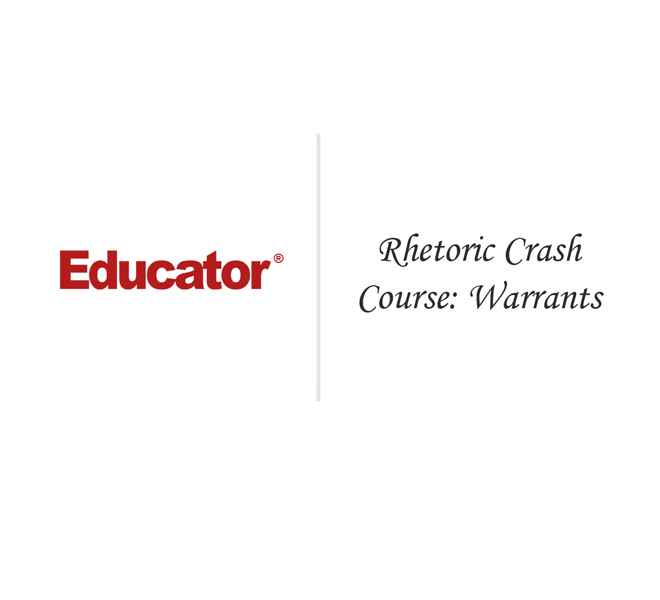
Rebekah Hendershot
Rhetoric Crash Course: Warrants
Table of contents, ap english language & composition rhetoric crash course: warrants.
Section 4: Rhetoric: Lecture 3 | 10:29 min
In the lesson, our professor Rebekah Hendershot goes through an introduction on a rhetoric crash course of warrants. She starts by reviewing the three elements of argument and then explains what a warrant is, the types of warrants and evaluation of warrants.
Share this knowledge with your friends!

Copy & Paste this embed code into your website’s HTML
- Show resize button - Allow users to view the embedded video in full-size.
Study Guides
Download lecture slides, related books & services.
Lecture Slides are screen-captured images of important points in the lecture. Students can download and print out these lecture slide images to do practice problems as well as take notes while watching the lecture.
Download All Slides
- Lesson Overview 0:11
- The Three Elements of Argument 0:38
- An Example 1:17
- What is a Warrant? 1:53
- May Not Be Stated At All in Your Essay
- Types of Warrants 3:14
- Authoritative Warrants
- Substantive Warrants
- Motivational Warrants
- Evaluation of Warrants 5:32
- Ask These Questions to Evaluate Authoritative Warrants
- Ask These Questions to Evaluate Substantive Warrants
- Ask These Questions to Evaluate Motivational Warrants
AP English Language & Composition
Related books.
Start Today!
- System Requirements
- Brand Logos
- © 2023 Educator, Inc. All Rights Reserved.
- Course Index

Please sign in to participate in this lecture discussion.
- Available 24/7. Unlimited Access to Our Entire Library.
Over 100+ comprehensive high school, college, and university courses taught by passionate educators.
Searchable Lessons
All lessons are segmented into easily searchable and digestible parts. This is to save you time.
Get Answers & Community Support
Ask lesson questions and our educators will answer it.
Downloadable Lecture Notes
Save time by downloading readily available lectures notes. Download, print, and study with them!
Study Guides, Worksheets and Extra Example Lessons
Practice makes perfect!
Start Learning Now
Our free lessons will get you started ( Adobe Flash ® required). Get immediate access to our entire library.
Membership Overview
- Search and jump to exactly what you want to learn.
- *Ask questions and get answers from the community and our teachers!
- Practice questions with step-by-step solutions.
- Download lecture slides for taking notes.
- Track your course viewing progress.
- Accessible anytime, anywhere with our Android and iOS apps.
Warrants in the Toulmin Model of Argument
- An Introduction to Punctuation
- Ph.D., Rhetoric and English, University of Georgia
- M.A., Modern English and American Literature, University of Leicester
- B.A., English, State University of New York
In the Toulmin model of argument , a warrant is a general rule indicating the relevance of a claim . A warrant may be explicit or implicit, but in either case, says David Hitchcock, a warrant is not the same as a premise . "Toulmin's grounds are premises in the traditional sense, propositions from which the claim is presented as following, but no other component of Toulmin's scheme is a premise."
Hitchcock goes on to describe a warrant as "an inference -licensing rule": "The claim is not presented as following from the warrant; rather it is presented as following from the grounds in accordance with the warrant"
Examples and Observations
"[T]he Toulmin warrant usually consists of a specific span of text which relates directly to the argument being made. To use a well-worn example, the datum 'Harry was born in Bermuda' supports the claim 'Harry is a British subject' via the warrant 'Persons born in Bermuda are British subjects.'"
"The connection between the data and the conclusion is created by something called a 'warrant.' One of the important points made by Toulmin is that the warrant is a kind of inference rule and in particular not a statement of facts."
"In enthymemes , warrants are often unstated but recoverable. In 'alcoholic beverages should be outlawed in the U.S. because they cause death and disease each year,' the first clause is the conclusion, and the second the data. The unstated warrant is fairly phrased as 'In the U.S. we agree that products causing death and disease should be made illegal.' Sometimes leaving the warrant unstated makes a weak argument seem stronger; recovering the warrant to examine its other implications is helpful in argument criticism. The warrant above would also justify outlawing tobacco, firearms, and automobiles."
- Philippe Besnard et al., Computational Models of Argument . IOS Press, 2008
- Jaap C. Hage, Reasoning With Rules: An Essay on Legal Reasoning . Springer, 1997
- Richard Fulkerson, "Warrant." Encyclopedia of Rhetoric and Composition: Communication from Ancient Times to the Information Age , ed. by Teresa Enos. Routledge, 1996/2010
- What Is the Toulmin Model of Argument?
- Backing (argument)
- Data Definition and Examples in Argument
- Definition and Examples of Conclusions in Arguments
- What Is an Argument?
- Propositions in Debate Definition and Examples
- Argument (Rhetoric and Composition)
- Inference in Arguments
- Premise Definition and Examples in Arguments
- Definition and Examples of Sorites in Rhetoric
- False Dilemma Fallacy
- Fallacies of Relevance: Appeal to Authority
- Bounty Land Warrants
- Definition and Examples of Syllogisms
- What Is Deductive Reasoning?
The Enlightened Mindset
Exploring the World of Knowledge and Understanding
Welcome to the world's first fully AI generated website!
What Are Warrants in Writing? A Comprehensive Guide for Writers
By Happy Sharer
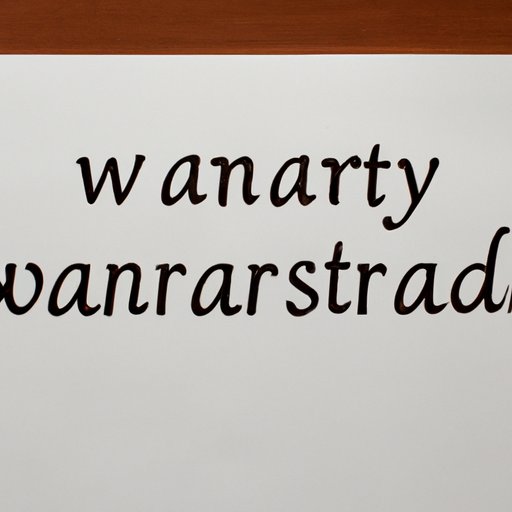
Introduction
When it comes to writing an argument, having a good understanding of warrants can make all the difference. But what exactly are warrants, and how do they differ from assertions? In this article, we’ll explore the basics of warrants in writing, including how to use them effectively in academic and persuasive writing, and tips on crafting a strong argument.
Explaining the Difference between Warrants and Assertions in Writing
Before delving into the specifics of warrants in writing, it’s important to understand the difference between warrants and assertions. An assertion is a statement that is made without providing evidence or proof to back it up. On the other hand, a warrant is an inference or assumption that is made based on evidence or proof, which is then used to support an argument.
For example, if you were arguing that the Earth is round, an assertion would be to simply state “The Earth is round” without providing any evidence or proof to back it up. On the other hand, a warrant might be to say “The Earth appears round when viewed from space, therefore it must be round” – this is an inference or assumption based on evidence (i.e. that the Earth appears round when viewed from space) that is used to support your argument.

How to Write an Argument Using Warrants
Now that you understand the difference between warrants and assertions, let’s look at how to use warrants to write an effective argument. The first step is to identify valid warrants for your argument. This means looking for evidence and facts that support your position and using them as the basis for your argument. For example, if you were arguing that a certain policy should be implemented, you would need to find evidence that supports why this policy should be implemented.
Once you have identified valid warrants for your argument, the next step is to craft a logical argument using these warrants. This means organizing your warrants in a way that builds a convincing case for your position. For example, if you were arguing that a certain policy should be implemented, you could start by outlining the benefits of the policy, followed by evidence that supports those benefits, and finally a conclusion that ties everything together.
Understanding Warrant-Based Arguments in Academic Writing
Warrants are also an important part of academic writing. When writing an academic argument, it’s important to use warrants to provide evidence and support for your claims. To do this, you’ll want to find reliable sources of information that can provide evidence for your argument. This could include research studies, scholarly articles, and other authoritative sources of information.
It’s also important to be aware of common pitfalls when crafting an academic argument with warrants. One of the most common mistakes is relying too heavily on personal opinion or unsupported assumptions. It’s important to remember that an academic argument should be based on evidence and logical reasoning, rather than opinion or speculation.
The Role of Warrants in Persuasive Writing
Warrants are also an important part of persuasive writing. When crafting a persuasive argument, it’s important to use warrants to strengthen your argument and convince readers of your point of view. To do this, you’ll want to find evidence that supports your position, such as research studies, expert opinions, and other authoritative sources of information.
You’ll also want to consider how to best use warrants to make your argument more persuasive. For example, you could use warrants to show how your position is supported by the majority opinion, or how it has been successful in the past. By using warrants to strengthen your argument, you can make it more convincing and compelling.

Using Warrants to Strengthen Your Writing Argument
Now that you understand the role of warrants in writing, let’s look at how to use them to strengthen your argument. The first step is to identify effective warrants for your argument. This means finding evidence and facts that support your position and using them as the basis for your argument. You’ll also want to consider the strength of each warrant and whether it is valid and reliable.
Once you have identified effective warrants for your argument, the next step is to apply them to your argument. This means organizing your warrants in a way that builds a convincing case for your position. For example, you could start by outlining the benefits of your position, followed by evidence that supports those benefits, and finally a conclusion that ties everything together.

Crafting a Strong Argument with Warrants
In addition to identifying and applying warrants to your argument, it’s also important to understand the different types of warrants and how to analyze them. There are two main types of warrants: factual warrants, which are based on evidence and facts; and philosophical warrants, which are based on logic and reasoning. It’s important to understand the difference between the two and how to use them effectively in your argument.
When analyzing warrants, it’s also important to consider the strength of each one. This means looking at the quality of the evidence and facts that support the warrant, as well as the logical reasoning behind it. If the warrant is weak or based on unreliable sources, it won’t be as effective in supporting your argument.
Analyzing Warrants in Writing: A Guide for Writers
Now that you know the basics of warrants in writing, let’s look at how to analyze them in order to strengthen your argument. The first step is to identify weak warrants. This means looking for evidence and facts that don’t support your argument or are based on unreliable sources. Once you’ve identified weak warrants, you can find ways to improve your argument by eliminating them or replacing them with stronger ones.
By understanding the role of warrants in writing, you can craft a strong and convincing argument. Warrants are an important part of any written argument, so it’s important to understand how to use them effectively. By following the steps outlined in this article, you can better understand warrants and use them to strengthen your argument.
In conclusion, warrants are an important part of any written argument. Understanding the difference between warrants and assertions, how to use them effectively in academic and persuasive writing, and how to analyze them can help you craft a strong and convincing argument. So the next time you’re writing an argument, keep in mind the importance of warrants and how to use them effectively.
(Note: Is this article not meeting your expectations? Do you have knowledge or insights to share? Unlock new opportunities and expand your reach by joining our authors team. Click Registration to join us and share your expertise with our readers.)
Hi, I'm Happy Sharer and I love sharing interesting and useful knowledge with others. I have a passion for learning and enjoy explaining complex concepts in a simple way.

Related Post
Unlocking creativity: a guide to making creative content for instagram, embracing the future: the revolutionary impact of digital health innovation, the comprehensive guide to leadership consulting: enhancing organizational performance and growth, leave a reply cancel reply.
Your email address will not be published. Required fields are marked *
Expert Guide: Removing Gel Nail Polish at Home Safely
Trading crypto in bull and bear markets: a comprehensive examination of the differences, making croatia travel arrangements, make their day extra special: celebrate with a customized cake.
English Composition 1
Developing effective arguments with claims, evidence, and warrants.
There are three major elements to persuasive writing and argumentation: claims, evidence, and warrants. Each is explained below.
- Thoreau believed that preoccupation with insignificant events caused nineteenth-century Americans to overlook what is important in life.
- Thoreau felt that technology was the primary cause of distress for nineteenth-century Americans.
- Thoreau thought that we should follow the ways of nature to lead more fulfilling lives.
- Thoreau felt that each individual has the responsibility to understand and reject the "shams and delusions" that are too often accepted as truths.
- Thoreau demonstrated his misanthropy (hatred of human beings) in his essay and saw no choice but to abandon civilization.
Notice how we could argue over the truth of the statements presented above. This fact alone should help you determine if you are presenting a claim. A claim, by its very nature, includes the possibility of at least two different, sometimes opposing, points of view. After all, there would be no reason to argue for a belief or interpretation if the subject of the belief or interpretation provided for only one possible point of view.
I think that most of the claims listed above could be argued well with specific evidence from Thoreau's essay, but I would be a little suspicious of one of the claims and downright skeptical about another one. To me, Thoreau seems disturbed by the emphasis on technological "improvements" in his day, such as the telegraph and railroad, but does he really believe that technology is the " primary cause of distress"? Right now, I really don't know, so I would wait to see how well the writer could support this interpretation before I would make up my mind. I approach the last claim with more skepticism, the claim that "Thoreau demonstrated his misanthropy (hatred of human beings) in his essay and saw no choice but to abandon civilization." Right now, I don't see Thoreau as a misanthrope, but I would be open to reading this writer's interpretation, examining carefully the way the writer argues this claim.
- that the claims really do convey your interpretation and are not simply statement of fact (see below), and
- that the claims can be supported with specific evidence.
Evidence is also referred to as support or facts . Evidence is just that: facts . Unlike claims, facts are indisputable. You may have heard the redundant phrase "true facts." The phrase is redundant because all facts are true: that's what makes them facts.
Evidence is what you use in persuasive writing to support the claims that you present.
Is it true that, in "Where I Lived, and What I Lived For," "Henry David Thoreau believed that preoccupation with insignificant events caused nineteenth-century Americans to overlook what is important in life"? The only way to find out is by examining the evidence. The evidence we should consider is easy to locate. We simply need to review Thoreau's essay and look for comments he makes that may support our claim. If we find such comments, these would be the facts we could use to support our interpretation.
- Thoreau says, "Men think that it is essential that the Nation have commerce, and export ice, and talk through a telegraph, and ride thirty miles an hour, without a doubt, whether they do or not; but whether we should live like baboons or like men, is a little uncertain."
Of course, this is a statement of fact. It is undoubtedly true that Thoreau made this comment in "Where I Lived, and What I Live For," so the sentence above might be good evidence to support a claim about Thoreau's essay. If someone questions if the sentence is true, the skeptic simply needs to open the book and read the passage. (But the quotation marks around the words above should make clear that these are Thoreau's actual words.)
Now, whether or not Thoreau's statement is a claim or a fact, whether people do or do not know if they should "live like baboons or like men," is irrelevant. Thoreau, in fact, is making a claim, but this is Thoreau's claim, not the claim of the writer using Thoreau's words as evidence. The fact that Thoreau made the comment, though, is indisputable.
All good arguments must be supported by a strong foundation of facts. An essay filled with claims but no supporting evidence is not really an argument at all. It is instead a collection of the writer's interpretations or beliefs, and readers will have no reason to believe the interpretations or beliefs is they are not well supported with facts.
How many facts do you need to support each claim that you make in a persuasive essay? Good question. To some extent, the amount of evidence you need depends on the claim you are trying to support. However, I think it's a good idea to present at least three facts to support each claim. One fact is almost never enough, and it's difficult to build a strong argument with only two facts. After all, I might be able to take one or even two statements that Thoreau makes and argue for all kinds of different meanings, ignoring the possibility that these meanings may not be suggested anywhere else in all of Thoreau's writings. Would you like someone drawing conclusions about beliefs you might have based upon only one statement you made at some point in your life?
Three facts seems to me the point when readers will start to be convinced that you have a well-supported interpretation. If you use at least three facts to support your interpretation of Thoreau's ideas, you are saying that Thoreau makes at least three different statements that all suggest the same thing to you, at least three statements that support your interpretation of Thoreau's beliefs. Could we draw a conclusion about some belief you may have based upon three statement you have made that suggest this belief? Well, we are more likely to be accurate than if we rely on only one statement to draw our conclusion.
- A Quotation : When you quote from the text, you copy the words exactly as they appear in the original , and you put quotation marks around the words you take from the text. Quotation marks tell readers that what they see in your essay is exactly what they would see in the original text.
- A Paraphrase : When you paraphrase, you put into your own words an idea that the writer conveys in the text. The paraphrase in itself should not convey any interpretation of the writer's ideas; instead, the paraphrase should be your own way of stating the exact idea that the writer conveys. In general, when you paraphrase, you use about the same number of words to convey the idea that the writer uses in the text. You should not put quotation marks around words you paraphrase, but you should make sure that you are conveying the same meaning that the writer conveys and that you really are using your own words to convey the idea.
- A Summary : When you summarize, you use considerably fewer words to convey a writer's ideas. A writer might make a good point that you could use as evidence to support your interpretation of the text, but the writer might develop this idea over several paragraphs. You would not want to bring such a long quotation into your essay, nor would you probably want to devote a large section of your essay to paraphrasing everything that the writer says. Instead, you could reread the information from the text carefully and then summarize the writer's points, perhaps using only a few sentences to convey an idea that the writer develops in a page or more. Of course, you need to make sure that your summary is accurate, that it really does convey concisely the points that the writer develops. When you summarize, you should not put quotation marks around your own words.
In general, writers will use a combination of quotations, paraphrases, and summaries when developing an interpretation of a text. Again, only words copies exactly from the original should go in quotation marks in your essay. In some cases, you might use paraphrases and summarizes to put the writer's ideas into your own words, but you might include a few key words or phrases from the original as part of your paraphrase or summary. If this is the case, you need to make sure that those key words and phrases from the original are in quotation marks.
Simply put, a warrant is the logical connection between a claim and a supporting fact. Sometimes, the logical connection, the way in which a fact logically supports a claim, will be clear, possibly so clear that no explanation from the writer is needed. More often, though, the writer needs to supply the warrant; in other words, the writer needs to explain how and why a particular piece of evidence is good support for a specific claim.
Look again at a claim and the one piece of supporting evidence for that claim I have mentioned so far as I discussed Thoreau's essay:
Claim: Henry David Thoreau believed that preoccupation with insignificant events caused nineteenth-century Americans to overlook what is important in life.
Evidence: Thoreau says, "Men think that it is essential that the Nation have commerce, and export ice, and talk through a telegraph, and ride thirty miles an hour, without a doubt, whether they do or not; but whether we should live like baboons or like men, is a little uncertain."
These two sentences could be the beginning of a paragraph. If so, what should my next sentence be? I suppose I could go on to present a second and then a third piece of supporting evidence for my claim, but am I sure that readers will be able to understand how the quotation I use is logically supporting my claim? I can assume that my readers are intelligent, so maybe they could figure out the connection, but I also should realize that, as the writer, it is my job to make sure everything in my essay is clear to readers. Therefore, I probably should supply some explanation as to how this quotation is supporting the claim, so my next sentence could be the following:
Warrant The apparent preoccupation with external events, with the commerce and business of everyday life, may cause people to focus on what they are doing and not to look inward to examine how they are living.
As I wrote this warrant, I looked at two things: the claim I am making and the piece of evidence I am using to support that claim. In fact, my eyes were darting back and forth between the two statements as I was writing the warrant. With the warrant, I try to bring together the claim and evidence, demonstrating to readers how and why the evidence logically supports the claim. In this case, I have even used in my warrant a few words from the claim and from the evidence to help clarify the relationship. In the warrant, I use the word "preoccupied," recalling my claim, and the word "commerce," recalling the evidence. Notice as well that the phrase " how [people] are living" from my warrant recalls an important phrase from my claim, "what is important in life," and an important phrase from my evidence, "'whether we should live like baboons or like men." With the warrant, I should not simply paraphrase the claim or the evidence but instead demonstrate how the evidence supports the claim.
After I add this warrant to my slowly developing paragraph, I am then ready for the next sentence. Most likely, the next sentence will use another piece of supporting evidence from Thoreau's essay, followed by my explanation of how this evidence supports the claim. I will continue this pattern until I feel that I have established a strong argument for my claim.
Once I am finished with the paragraph, I am then ready to move on to the next paragraph. Most likely, I will repeat this same pattern with a different claim, but one related to my first claim. I will begin the body paragraph with a claim, followed by more supporting evidence and more explanation of how each piece of evidence supports my claim for that paragraph.
Copyright Randy Rambo , 2019.

What is a Warrant in Writing?

Written by Haley Boyce

Before we do a swan dive into warrants, we will need to wade the waters of its origin. Warrants are just one part of a bigger product known as the rhetorical analysis essay.
Rhetoric is the term used to describe ideas about different texts. When you read a story (or article, essay, journal, etc.) and share your thoughts about it, those thoughts are now called rhetoric. When you read a text and have thoughts about them, those thoughts are called rhetoric. It’s one of those words that sounds fancy and feels a little intimidating when, truly, it’s got a relatively simple definition.
Warrants are similar in that they, too, sound super complicated but have a somewhat simple meaning. The difference, however, is that warrants are best defined with a lengthier explanation and examples. So, let’s get down to it.
What is the Definition of a Warrant in Writing?
In persuasive writing you will make a claim at the beginning of your essay. Then the rest of your essay will be spent proving why your claim is correct and why your reader should agree with you.
The warrant is the connection the reader can make between the claim and evidence.
When a writer makes a claim and provides evidence, they will explain why the evidence supports the claim or they will imply the connection but leave the clarity as an assumption for the reader to make.
What are the Different Types of Warrants in Writing?
There are two types of warrants in writing. The
Explicit Warrant:
An explicit warrant is used when a writer feels that the argument will need stronger support for the reader to agree with, or even understand. Explicit warrants are identifiable when the writer clearly explains why the evidence they are providing supports the claim.
Implicit Warrant:
An implicit warrant is used when an argument is strong enough without blatantly stating why the connection between the claim and the evidence. For example:
- Claim: Flying in a hot air balloon is safe.
- Support: The Federal Aviation Administration regulates hot air balloon safety.
- Warrant: The FAA is trustworthy and would not permit unsafe travel.
Stephen Toulmin Warrants Some Attention

In “The Uses of Argument”, he posited that formal logic was too abstract and an inadequate representation of how we actually argue. Roy Pea, a professor of learning sciences and education and director of the Stanford Center for Innovations in Learning at Stanford University said that Toulmin “ “argued that if we want to understand questions of ethics, science and logic, we have to inquire into the everyday situations in which they arise.”
Determined to set a new standard for how we argue, especially in academic papers, Toulmin developed what we now know in academia as the Toulmin Model. The model is a tool in the analysis of arguments, allowing one to weigh the strengths and weaknesses in arguments. This is the model used when we write warrants.
Responses to this question vary by philosopher and professor alike, but there are several agreed upon factors to consider while writing a warrant. Whether your warrant is explicit or implicit, take the following into consideration as you write.
A good warrant should:
- Be a reasonable interpretation of the facts
- Not make illogical leaps of interpretation
- Not assume more than the evidence supports
- Consider and prepare to respond to possible counterarguments
More to consider while writing your warrant:
- Do you readers already know the warrant?
- Will readers believe the warrant is true?
- Will readers see the connection to the claim and evidence the same way that you do? If not, you will need to reconsider your evidence or make your warrant explicit.
- Because the purpose of having a warrant is to persuade your reader to agree with you, will your reader see the relevance of your argument as important to their own lives? Again, if the answer to this is “no”, then you will need to explicitly state your warrant.
Presenting Counterarguments Can Be the Most Powerful Way to Support Your Own Point

In persuasive writing, the counterargument must be acknowledged in some way. Doing so gives credibility to your argument because it shows that you are writing from a sound mind that is not ignorant to opposing viewpoints. It says to the reader, “I believe this to be true because I have looked at all possibilities and see how my belief is the correct one.”
A simple structure for writing a counterargument can go something like this:
- Identify the opposing argument.
- Respond to the opposing argument by discussing the reasons the argument is illogical or weak.
- Provide examples or evidence to show why the opposing argument is illogical or weak.
- Finally, re-state your own argument and why it is stronger than the counterargument.
Table of Contents
Ai, ethics & human agency, collaboration, information literacy, writing process.
Warrants are assumptions that link claims to grounds. Warrants can be scientific laws, principles of historical interpretation, a law statute or psychological generalization about human behavior. Warrants may be implied or explicitly stated to support an argument.

Brevity - Say More with Less

Clarity (in Speech and Writing)

Coherence - How to Achieve Coherence in Writing

Flow - How to Create Flow in Writing

Inclusivity - Inclusive Language

The Elements of Style - The DNA of Powerful Writing

Suggested Edits
- Please select the purpose of your message. * - Corrections, Typos, or Edits Technical Support/Problems using the site Advertising with Writing Commons Copyright Issues I am contacting you about something else
- Your full name
- Your email address *
- Page URL needing edits *
- Name This field is for validation purposes and should be left unchanged.
Other Topics:

Citation - Definition - Introduction to Citation in Academic & Professional Writing
- Joseph M. Moxley
Explore the different ways to cite sources in academic and professional writing, including in-text (Parenthetical), numerical, and note citations.

Collaboration - What is the Role of Collaboration in Academic & Professional Writing?
Collaboration refers to the act of working with others or AI to solve problems, coauthor texts, and develop products and services. Collaboration is a highly prized workplace competency in academic...

Genre may reference a type of writing, art, or musical composition; socially-agreed upon expectations about how writers and speakers should respond to particular rhetorical situations; the cultural values; the epistemological assumptions...

Grammar refers to the rules that inform how people and discourse communities use language (e.g., written or spoken English, body language, or visual language) to communicate. Learn about the rhetorical...

Information Literacy - Discerning Quality Information from Noise
Information Literacy refers to the competencies associated with locating, evaluating, using, and archiving information. In order to thrive, much less survive in a global information economy — an economy where information functions as a...

Mindset refers to a person or community’s way of feeling, thinking, and acting about a topic. The mindsets you hold, consciously or subconsciously, shape how you feel, think, and act–and...

Rhetoric: Exploring Its Definition and Impact on Modern Communication
Learn about rhetoric and rhetorical practices (e.g., rhetorical analysis, rhetorical reasoning, rhetorical situation, and rhetorical stance) so that you can strategically manage how you compose and subsequently produce a text...

Style, most simply, refers to how you say something as opposed to what you say. The style of your writing matters because audiences are unlikely to read your work or...

The Writing Process - Research on Composing
The writing process refers to everything you do in order to complete a writing project. Over the last six decades, researchers have studied and theorized about how writers go about...

Writing Studies
Writing studies refers to an interdisciplinary community of scholars and researchers who study writing. Writing studies also refers to an academic, interdisciplinary discipline – a subject of study. Students in...
Featured Articles

Academic Writing – How to Write for the Academic Community

Professional Writing – How to Write for the Professional World

Credibility & Authority – How to Be Credible & Authoritative in Speech & Writing
The Art of the Warrant: Connecting Evidence to Claims
Mike peterson, ph.d., utah tech university.
Most academic writing depends on claims, warrants, and evidence, so the more you know about how they function together, the better you'll be at not only writing persuasive papers, but picking apart other-people's arguments.
What is a Claim?
I had a teacher once give me an interesting piece of advice: Never start a paragraph with a fact. Always start with a claim. Since she was in charge of my grade, I obeyed. I was also willing to try it because she promised it would make my writing more compelling. It proved a bit problematic with introductions and conclusions, but I found that when writing "body" paragraphs, starting with a claim was no more difficult than starting with a fact. She might have explained this, but it didn't sink in until later, but what she was asking me to do was to start each paragraph with a topic sentence. I applied her rule for most of my college career, but by the time I graduated, I realized that while it was a convenient little trick, it wasn't necessarily the wisest choice in every writing situation. I found, for example, that I prefer to write short paragraphs. Rather than containing my ideas into stand-alone paragraphs with a topic sentence and all the necessary evidence and details, I tend to cluster my ideas into groups of small paragraphs. Starting each of these little paragraphs with a claim doesn't work quite the same as when you're writing a "five-paragraph theme" essay.
A claim is simply a debatable statement based on the interpretation of evidence, but not a mere statement of fact.
Example of a Statement of Fact:
According to the 2011 NOAA Index, August is the hottest month of the year in southern Utah.
This isn't a particularly interesting piece of information. I can see why my old professor would roll her eyes if I started a paragraph with it. But it is a great piece of evidence. The NOAA Index is indisputable, so if I needed some proof that August is hot, there you go.
Example of a Claim:
Despite it being the hottest month of the year, August is actually a great time to begin training for a marathon.
If you write something, and you can anticipate someone asking what you are basing that on, then chances are you've just written a claim. Bravo. I don't run marathons, but I have many friends who do. If I said that August is the best time to begin training, no doubt some would guffaw and tell me I'm wrong, while others would say, "Now hold on—he might be onto something." That's the beauty of a claim. It gets the reader thinking. It causes them to think of whether they agree or disagree, and it leaves them wanting to know on what you are basing your claim.
The two key types of claims you will make in writing are thesis statements and topic sentences. A thesis statement is the central claim you make in your paper. It's your main argument. Everything in the paper should be in service of supporting your thesis statement. It is usually found in the first paragraph (or in the introductory material, which might be the first few paragraphs) and is often repeated in the conclusion (but not always; that's a stylistic choice).
A topic sentence is similar to a thesis statement, but it is the main claim of a specific paragraph or section. As I've mentioned, it is usually found in the first sentence or two of a paragraph, but not always.
If you find it useful, here are a few more example of claims and mere statements of fact:
It's important to note that some of these claims are easier to prove than others. But just because a claim can't be proven doesn't mean it isn't valid or worth making. Even though you can't prove that Terminator 2 is the best film in the franchise (which it is), you can certainly substantiate that claim by identifying what makes a film entertaining and then showing how Terminator 2 meets and exceeds those criteria compared to the other films.
What is Evidence?
Anything that proves, substantiates, or otherwise backs up your claim is evidence. Evidence can include but is not limited to:
Personal Examples
Quotes by experts, users, witnesses, etc.
Logic and syllogism (if A is B, and B is C, then A is C)
Primary and secondary sources
And much, much more!
While making a claim might come rather naturally to you (we are, after all, an opinionated and contradictory species), providing sufficient evidence to prove or substantiate your claim can be tricky. That’s why you'll be asked to dedicate so much of your time this semester finding, evaluating, and incorporating sources into your writing, as well as writing compelling narratives, accurate descriptions, and sound analyses. All of these things will combine to provide you the firepower (aka evidence) you need to back up your claims, prove your point, win your arguments, and persuade your readers.
Though you may not realize it, you probably have asked people quite often what evidence they're using to support their claim. When someone makes some sort of claim that I don't agree with, my first question is usually, "What are you basing that on?" If you find yourself saying that, or something similar ("Where did you get that idea?" Or, "What makes you say that?"), then what you're really saying is, "Please provide me with the necessary evidence to back up your claim."
Not all evidence is created equal. What your buddies and your professor accept as solid evidence might not be the same. Something that might seem perfectly reasonable to you might seem utterly absurd to me. Why is that?
Shouldn't a piece of evidence support the claim equally no matter who is reading your paper? You would think so, but no. To understand why, it's important to know what a warrant is and how they work differently with different readers.
What is a Warrant?
A warrant, simply put, is the assumption that your reader needs to agree with in order to find your evidence strong enough to support your claim. Your warrant may be directly stated, or it might just be implied.
Though you may have never used the word warrant in this way, you actually use warrants all the time, and you even recognize when a warrant just isn't working.
Suppose, for example, your roommate tells you to try this magic new pill to help you lose weight fast. After you eye it suspiciously, you ask if it's safe. "Of course it's safe," she says. "It's been FDA approved!"
Within this scenario, you have a claim, a warrant, and a piece of evidence. Can you tell which is which?
The claim: This pill is safe.
The evidence: It has been approved by the FDA.
The warrant: The FDA is trustworthy and would never approve an unsafe medication.
In this example, the warrant is left unstated. It is the underlying assumption that you must believe in order for the evidence to back up the claim. But if you're like me and you really don't place that much trust in the FDA, then you probably aren't going to be convinced to take that pill. The claim is fine, the evidence is solid, but the warrant (the assumption that links the evidence with the claim) loses us.
You then say to your roommate, "FDA approval means nothing to me. Those guys are notorious for approving unsafe drugs. I'm not taking this." What you're actually saying is, "I don't agree with your implied warrant, therefore your evidence doesn't support your claim."
But you would never say that, just as your roommate would never say, "Let me, then, provide you with another piece of evidence with a warrant that appeals to you." Instead, she says, "Hear me out. I've been taking it for three months and I feel great, and both my sisters have used it for over a year and they swear by it."
You have to admit your roommate looks pretty good, and she certainly seems healthy. And if other people have seen such success with no side effects, then maybe it really is safe. The warrant, or the underlying assumption here, is that since three people have taken it for several months with no ill effects, then you too will experience similar results. You buy into that assumption, therefore the evidence (it worked for your roommate and two others) is sufficient to support the claim (the pill is safe).
We evaluate claims, warrants, and evidence all the time in casual conversations--even when we don't realize it. We are constantly making claims and searching for evidence that the people with whom we are speaking will find compelling—and what makes it compelling often lies at the level of the warrant--the assumption--that they must believe in order for them to value the evidence enough to buy into your claim.
Logic Bridges: How did you get from there to here?
Another way I like to think of the connection between claims, warrants, and evidence is in terms of logic bridges. When someone makes a claim and provides evidence, I often think, "How did you get from there to here ?" How did you get from seeing that the magic pill was FDA approved to claiming that it is perfectly safe and everyone should take it? A lot has to happen at the warrant level, the assumption level, to get from there to here. I call this a logic bridge. This is useful not only in helping you identify what a warrant is (even if it's not directly stated), but also in figuring out in general how and when an argument breaks down.
Here, for your viewing pleasure, are a few more examples of claims, warrants, and evidence.
EnglishComposition.Org
Be a Better Writer
The Toulmin Model of Argument
The Toulmin Model is a tool for analyzing and constructing arguments. It was created by British philosopher Stephen Toulmin and consists of the following six parts:
The argument being made, a statement that you want the audience to believe, accept, or act upon.
The evidence that supports your claim.
The logic or assumptions that connect your evidence to the claim. A statement of how your evidence logically and justifiably supports your claim. Warrants are often left unstated and commonly take one of the following six forms:
Warrant Based Generalization: What is true of the sample is likely true of the whole.
Warrant Based on Analogy: What is true of one situation is likely true of another, so long as they share key characteristics.
Warrant Based on Sign: One thing indicates the presence or outcome of something else. For example, we can diagnose an illness or disease by its symptoms. People who own expensive things likely have a lot of money.
Warrant Based on Causality: One thing causes another. For example, eating too much sugar is the cause of numerous health conditions.
Warrant Based on Authority: An indication that something is true because an authority or group of authorities affirms it. For example, nearly all of the planet’s esteemed scientists say that climate change is real.
Warrant Based on Principle: An agreed-upon value or rule applied to a specific scenario. For example, parents should love their children is a widely-shared value. Backing (or refuting) that this value should apply to a specific parent in question might be the goal of an attorney in a criminal trial.
Warrants are important because if your audience does not accept your warrant, they are not likely to accept your argument. Warrants can be questioned, which is why they often require backing.
Support for the warrant. It might take the form of a well-reasoned argument (or sub-argument) that directly strengthens the warrant. So for example, let’s say your argument depends on a warrant of causality. To strengthen your warrant, you might give additional evidence that shows that the causal relationship is not really just a simple correlation.
Counterarguments to your claim. Situations where your claim does not hold true. This may also include your response to the counterargument.
The degree of certainty in your argument. Your argument may state that something is true 100 percent of the time, most of the time, or just some of the time. Words used to moderate the strength of your argument include always , sometimes , usually , likely , loosely , etc.
Your claim may also be qualified based on your analysis of the opposing arguments.
Example of the Toulmin Model Applied to an Argument
Let’s break down the following argument:
Schools should ban soda from their campuses to protect student health.
Claim: Schools should ban soda from their campuses.
Grounds : Banning soda would protect student health.
Warrant 1: Poor diet leads to health problems in adolescents.
Warrant 2: Schools have a responsibility to protect student health.
Backing for Warrant 1: Studies show a high correlation between sugary drinks and obesity rates.
Backing for Warrant 2: Schools try to provide for the well-being of students in many other ways, such as campus security and counseling for behavioral and mental health.
Rebuttal : Banning soda from school campuses won’t prevent students from drinking it at home.
Qualifier: Even though students would still have access to soda before and after school, banning soda from school campuses would reduce their overall consumption, which is an important contribution toward protecting their health and well-being.
Link: Argumentative Essay Using Toulmin Strategies
Check out the video for a quick review.
Though argumentative analysis can never be reduced entirely to a formula, the Toulmin model, along with other models of persuasion , can increase your understanding of how arguments work (and don’t work).

An Example for Rhetorical Analysis
A publish.illinois.edu site
What are Warrants?
Warrants refer to what the author values. What is the main difference between warrants and the thesis? I think an important difference is that one argument can have several warrants, while the thesis is unique. Warrants are not stated directly in an argument, but they are reflected in the thesis, the author’s tone and the author’s way of description and so on. For example, we can often regard “ecology” as the warrant of an article assailing air pollution caused by factories.
An Analysis Example:
I think “genetic diversity”, “future need for genetic resources” and “agricultural and economical value of genetic resources” are the warrants of this paper. We can easily see what the author values from her thesis and descriptions in this paper. For example, the vocabulary “genetic diversity” repeatedly appears in the paper. And the author claimed in the paper that “In the present case, the strategies of conservation are concerned with the maintenance of the economically and agriculturally valuable aspects of genetic resources”. (Peres 100) The most important warrant is still genetic diversity though, as the main content of the paper discusses how seed banks can protect genetic resources, thus promoting the cause of protecting genetic diversity and ensuring the positive evolution of plants in the future.
Want to create or adapt books like this? Learn more about how Pressbooks supports open publishing practices.
Elements of Argument
9 Toulmin Argument Model
By liza long, amy minervini, and joel gladd.
Stephen Edelston Toulmin (born March 25, 1922) was a British philosopher, author, and educator. Toulmin devoted his works to analyzing moral reasoning. He sought to develop practical ways to evaluate ethical arguments effectively. The Toulmin Model of Argumentation, a diagram containing six interrelated components, was considered Toulmin’s most influential work, particularly in the fields of rhetoric, communication, and computer science. His components continue to provide useful means for analyzing arguments.

The following are the parts of a Toulmin argument (see Figure 9.1 for an example):
Claim: The claim is a statement that you are asking the other person to accept as true (i.e., a conclusion) and forms the nexus of the Toulmin argument because all the other parts relate back to the claim. The claim can include information and ideas you are asking readers to accept as true or actions you want them to accept and enact. One example of a claim is the following:
My grandfather should wear a hearing aid.
This claim both asks the reader to believe an idea and suggests an action to enact. However, like all claims, it can be challenged. Thus, a Toulmin argument does not end with a claim but also includes grounds and warrant to give support and reasoning to the claim.
Grounds: The grounds form the basis of real persuasion and include the reasoning behind the claim, data, and proof of expertise. Think of grounds as a combination of premises and support. The truth of the claim rests upon the grounds, so those grounds should be tested for strength, credibility, relevance, and reliability. The following are examples of grounds:
Over 70% of all people over 65 years have a hearing difficulty. Hearing aids raise hearing quality.
Information is usually a powerful element of persuasion, although it does affect people differently. Those who are dogmatic, logical, or rational will more likely be persuaded by factual data. Those who argue emotionally and who are highly invested in their own position will challenge it or otherwise try to ignore it. Thus, grounds can also include appeals to emotion, provided they aren’t misused. The best arguments, however, use a variety of support and rhetorical appeals.
Warrant: A warrant links data and other grounds to a claim, legitimizing the claim by showing the grounds to be relevant. The warrant may be carefully explained and explicit or unspoken and implicit. The warrant answers the question, “Why does that data mean your claim is true?” For example,
A hearing aid helps most people hear better.
The warrant may be simple, and it may also be a longer argument with additional sub-elements including those described below. Warrants may be based on logos, ethos or pathos, or values that are assumed to be shared with the listener. In many arguments, warrants are often implicit and, hence, unstated. This gives space for the other person to question and expose the warrant, perhaps to show it is weak or unfounded.
Backing: The backing for an argument gives additional support to the warrant. Backing can be confused with grounds, but the main difference is this: grounds should directly support the premises of the main argument itself, while backing exists to help the warrants make more sense. For example,
Hearing aids are available locally.
This statement works as backing because it gives credence to the warrant stated above, that a hearing aid will help most people hear better. The fact that hearing aids are readily available makes the warrant even more reasonable.
Qualifier: The qualifier indicates how the data justifies the warrant and may limit how universally the claim applies. The necessity of qualifying words comes from the plain fact that most absolute claims are ultimately false (all women want to be mothers, e.g.) because one counterexample sinks them immediately. Thus, most arguments need some sort of qualifier, words that temper an absolute claim and make it more reasonable. Common qualifiers include “most,” “usually,” “always,” or “sometimes.” For example,
Hearing aids help most people.
The qualifier “most” here allows for the reasonable understanding that rarely does one thing (a hearing aid) universally benefit all people. Another variant is the reservation, which may give the possibility of the claim being incorrect:
Unless there is evidence to the contrary, hearing aids do no harm to ears.
Qualifiers and reservations can be used to bolster weak arguments, so it is important to recognize them. They are often used by advertisers who are constrained not to lie. Thus, they slip “usually,” “virtually,” “unless,” and so on into their claims to protect against liability. While this may seem like sneaky practice, and it can be for some advertisers, it is important to note that the use of qualifiers and reservations can be a useful and legitimate part of an argument.
Rebuttal: Despite the careful construction of the argument, there may still be counterarguments that can be used. These may be rebutted either through a continued dialogue, or by pre-empting the counter-argument by giving the rebuttal during the initial presentation of the argument. For example, if you anticipated a counterargument that hearing aids, as a technology, may be fraught with technical difficulties, you would include a rebuttal to deal with that counterargument:
There is a support desk that deals with technical problems.
Any rebuttal is an argument in itself, and thus may include a claim, warrant, backing, and the other parts of the Toulmin structure.
Even if you do not wish to write an essay using strict Toulmin structure, using the Toulmin checklist can make an argument stronger. When first proposed, Toulmin based his layout on legal arguments, intending it to be used analyzing arguments typically found in the courtroom; in fact, Toulmin did not realize that this layout would be applicable to other fields until later. The first three elements–“claim,” “grounds,” and “warrant”–are considered the essential components of practical arguments, while the last three—“qualifier,” “backing,” and “rebuttal”—may not be necessary for all arguments.
Toulmin Exercise
Find an argument in essay form and diagram it using the Toulmin model. The argument can come from an Op-Ed article in a newspaper or a magazine think piece or a scholarly journal. See if you can find all six elements of the Toulmin argument. Use the structure above to diagram your article’s argument.
Attributions
“Toulmin Argument Model” by Liza Long, Amy Minervini, and Joel Gladd is licensed under CC BY-NC-SA 4.0
Writing Arguments in STEM Copyright © by Jason Peters; Jennifer Bates; Erin Martin-Elston; Sadie Johann; Rebekah Maples; Anne Regan; and Morgan White is licensed under a Creative Commons Attribution-ShareAlike 4.0 International License , except where otherwise noted.
Share This Book
Feedback/errata.
Comments are closed.

Chapter 5: Maintaining Focus and Purpose: The Body Paragraphs
Claim, Evidence and Warrant

Body paragraphs will often begin with a claim , then cite some evidence , then develop the warrant by reading the evidence through the claim; however, you should not regard these three elements as immovable parts of a rigid formula of 1+1+1=3. Claim, evidence and warrant should work together more organically than that. You will rarely make a claim without connecting it immediately to evidence. Nor will you simply cite evidence without reading it through the lens of your claim. Better to keep an eye to your thesis and outline and make sure you are always reading the text the way you want your audience to consider it. To understand exactly how this works, let’s compare our intended purpose for Paragraph 1 as detailed in our outline with the actual Paragraph 1 as it appears in our essay. In the final version of Paragraph 1, the evidence is bold and the claim is in italics .
Paragraph 1 (First Storey): quote and unpack the contrast of “cooperation” and “conflict”
Body Paragraph 1:
In his coy opening paragraphs, Justice describes the many uses of language as if they are features of a “new communications app” he “just invented.” Justice notes how language use “facilitates an expanding network of people” and “opens up incredible possibilities for creativity and cooperation. ” Such clever itemization of language’s many features enables Justice to establish effectively language as a human tool that has at its root the human desire to connect and work together. Though centuries of migration and conflict may have turned the world into a “ Tower of Babel” in which populations are divided by different languages, “all of us living today have a common history” in which language was developed first and foremost to create community.
The whole paragraph works toward our analysis that Justice is really writing about how language, so often used as a demonstration of what divides us, is really symbolic of our common desire to work together, and how if used properly, it can overcome any difference or distance. The whole paragraph is essentially the warrant , punctuated by the transitional last line that claims Justice believes “language was developed first and foremost to create community.” Our choice of what evidence we use is not arbitrary and indicates our intended reading of this text. Our description of Justice’s writing as “coy” and “clever” persuades our reader toward our interpretation of the text—an assertion that what is undeniably in the text is doing what we in fact claim it is doing.
Write Here, Right Now: An Interactive Introduction to Academic Writing and Research Copyright © 2018 by Ryerson University is licensed under a Creative Commons Attribution 4.0 International License , except where otherwise noted.

Descriptive Essay
Descriptive essay generator.

Essays are written due to various reasons and purposes. Some of the authors want to inform, some want to expose while some want to persuade. However, in descriptive essay writing , the essayist composes for the sake of displaying a picture out of his/her describing words. It may sound easy and simple but don’t be deceived, there are still more to learn. Read through this article to get hold of significant and beneficial new knowledge.
What is Descriptive Essay? A descriptive essay is a type of writing that aims to vividly describe a person, place, object, or event. In this type of essay, the writer uses sensory details such as sight, sound, smell, taste, and touch to create a clear and vivid image in the reader’s mind. The goal of a descriptive essay is to evoke a strong emotional response or create a vivid impression of the subject being described.
Descriptive Essay Format
Introduction.
Hook: Start with a sentence that captures the reader’s attention. This could be a striking fact, a question, or a vivid description. Context: Provide some background information to set the scene. Describe the setting, the situation, or the object of the essay. Thesis Statement: End the introduction with a clear thesis statement that outlines the main aspects or the overall impression of your subject.
Body Paragraphs
Each body paragraph should focus on a specific aspect or a detail that contributes to the overall picture you are trying to paint. Use the “show, don’t tell” technique by employing vivid imagery and sensory details.
Paragraph 1: Sight
Topic Sentence: Introduce the aspect of sight. Details: Describe what you see in vivid detail. Use adjectives and adverbs to bring the scene to life. Closing Sentence: Wrap up the paragraph by summarizing the importance of the visual details.
Paragraph 2: Sound
Topic Sentence: Focus on the sounds related to your topic. Details: Describe what can be heard, whether it’s the background noise, a specific sound related to the subject, or the absence of sound. Closing Sentence: Conclude by explaining how the sounds contribute to the overall impression.
Paragraph 3: Smell
Topic Sentence: Highlight the aspect of smell. Details: Describe the aromas and scents. Whether it’s pleasant or pungent, detail how it impacts the scene or the subject. Closing Sentence: Summarize how the smell adds to the depth of your description.
Paragraph 4: Touch
Topic Sentence: Discuss the sense of touch. Details: Describe the textures and temperatures. Explain how something feels to the touch and why it’s important to your description. Closing Sentence: Link the tactile details to the overall experience.
Paragraph 5: Taste (if applicable)
Topic Sentence: Introduce the sense of taste, if relevant. Details: Describe the flavors and the experience of tasting something related to your subject. Closing Sentence: Reflect on how taste enhances the description.
Summary: Briefly restate your thesis and summarize the main points of your essay. Significance: Explain the significance of the subject and the impact it has made on you or the impression it leaves. Closing Thought: End with a final thought or reflection, leaving the reader with something to ponder.
Example of Descriptive Essay
“The Sunset at the Beach” As I walked down the sandy path towards the ocean, the first thing that struck me was the vast expanse of the sea, stretching endlessly towards the horizon. The sun was beginning to set, painting the sky in shades of orange, pink, and purple. The beauty of the sunset at the beach was a breathtaking spectacle that I had come to witness. Introduction The beach has always been a place of serenity for me, especially during the sunset. The way the sun dipped below the horizon, leaving behind a tapestry of colors, always seemed magical. On this particular evening, the scene was set for a perfect display of nature’s artistry. Body Paragraphs The Vision of the Sunset As I stepped onto the soft, warm sand, my eyes were immediately drawn to the horizon. The sun, a fiery orb, was slowly descending, casting its golden glow across the sky. The clouds, mere wisps earlier in the day, now looked like cotton candy, stained with hues of pink and lavender. The reflection of the sunset on the water added a layer of brilliance to the scene, with the light dancing on the waves as they gently lapped against the shore. The Symphony of the Waves The sound of the waves provided a soothing background melody to the visual spectacle. Each wave crashed against the shore with a rhythm that was both calming and invigorating. In the distance, seagulls called to one another, their cries adding to the orchestral performance of nature. The rustling of the palm leaves in the gentle breeze played a soft, whispering harmony, creating a symphony that only the beach at sunset could offer. The Aromatic Breeze With every breath, the salty tang of the sea air filled my lungs, a distinctive aroma that immediately relaxed my body and mind. There was a freshness to it, a reminder of the vast, untamed ocean before me. Mixed with the faint scent of sunscreen and the earthiness of wet sand, the beach’s aroma was invigorating, grounding me in the moment. The Touch of Nature As I walked along the water’s edge, the cool water washed over my feet, providing relief from the day’s residual heat. The sand, now cooler than the afternoon sun, felt soft and comforting beneath my toes. Occasionally, a stronger wave would rush further up the beach, encouraging me to dig my feet into the sand, feeling the grains shift against my skin. Conclusion The sunset at the beach was not just a visual masterpiece; it was an experience that engaged all the senses. As the sun finally disappeared, leaving behind a sky painted in dark blues and purples, I felt a sense of peace and contentment. The beach at sunset had offered me a moment of beauty, tranquility, and a deep connection with nature. It was an unforgettable scene, etched in my memory, reminding me of the simple, yet profound joys of life.
Descriptive essays generally focus more on visualizing a specific topic of interest. Considering that aspect, showing you what it looks like may be helpful as well. Thus, we cautiously gathered the best samples and templates of descriptive essays for you to rely on, here are they:
Bright Topic Ideas for Your Descriptive Essay
The list of the possible topic ideas for your descriptive essay is limitless. There are a lot of choices to choose from and sometimes, it is really difficult to pick one. If you are being indecisive regarding your topic idea, here are some smart concepts to help you select one.
Descriptive Essay Ideas About People
- Description of your favorite music genre
- Treating a popular villain as a good protagonist
- The right words that would compliment your singing idol
- Why your squad is the best?
- What qualities should your future spouse possess?
- Why your aunt is the best?
Descriptive Essay Ideas About Places
- Why Manila Bay has the best sunset?
- The perfect adjective to describe your hometown
- Details on your recent vacation destination
- Why your favorite coffee shop is worth the visit?
- What makes Paris unique?
- The best description for your workplace
Descriptive Essay Ideas About Things
- Why your wedding ring is the most luxurious?
- The description of your favorite blanket
- What makes your research paper great?
- Description of your proposed food product
- Perfume: more than just the bottle
- Why your bag is great
Descriptive Essay Examples & Templates
Descriptive narrative essay example.

Descriptive Essay Outline Example

Short Essay Plan Example
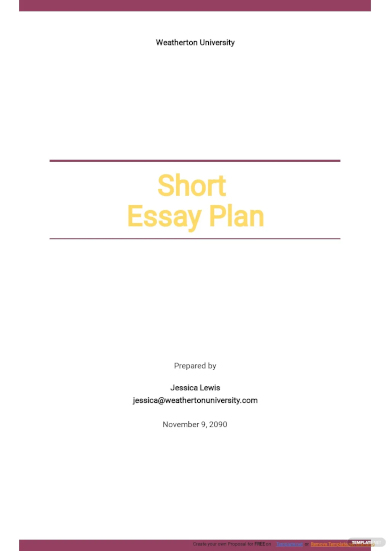
Biographical Narrative Essay Example

College Narrative Essay Example
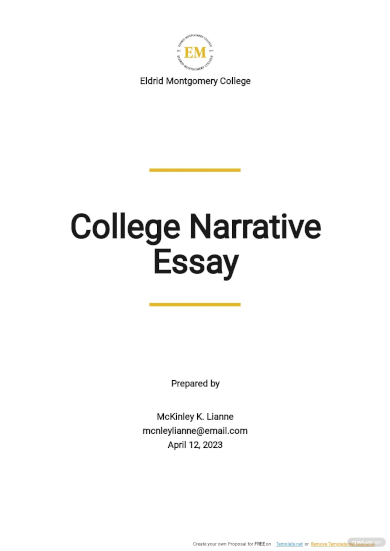
Personal Narrative Essay Example

Short Narrative Essay Example
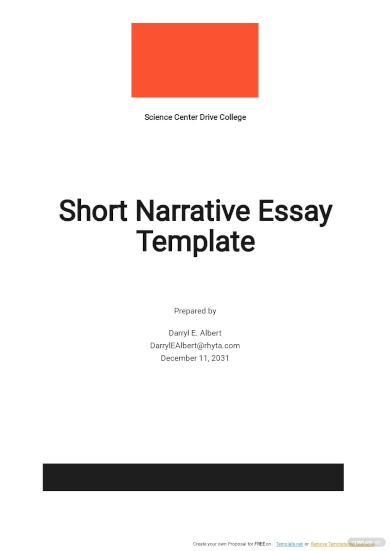
High School Descriptive Essay Example

Free Simple Descriptive Essay Plan
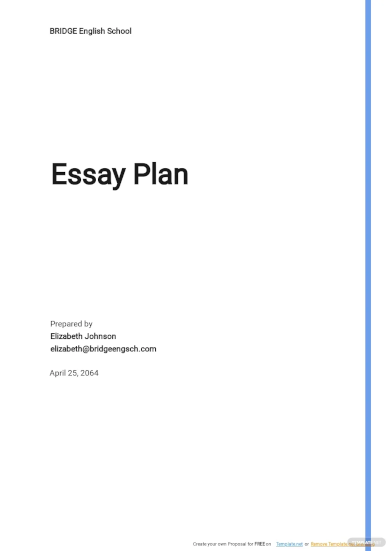
Basic Descriptive Essay Writing Example

latterdaylearning.org
Short Descriptive Essay Example

trudyamiller.wikispaces.com
Descriptive Essay Structuring Example
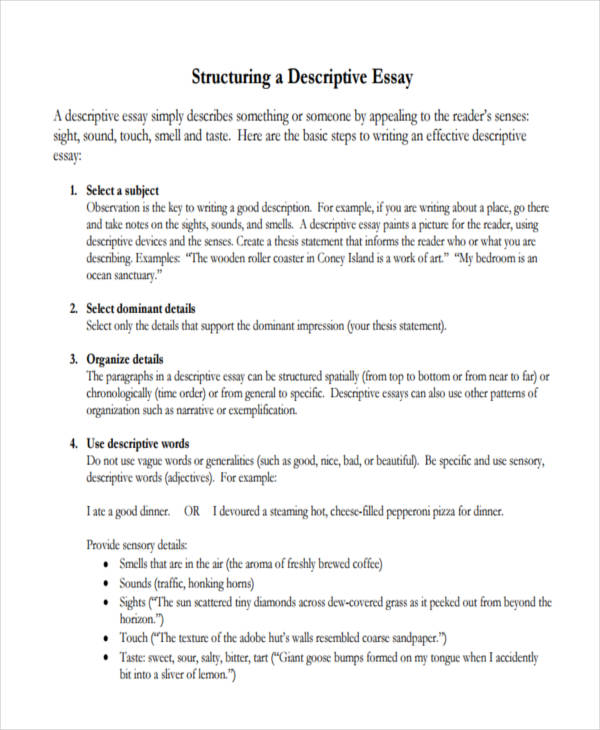
colegiobennett.org
Simple Descriptive Essay Example
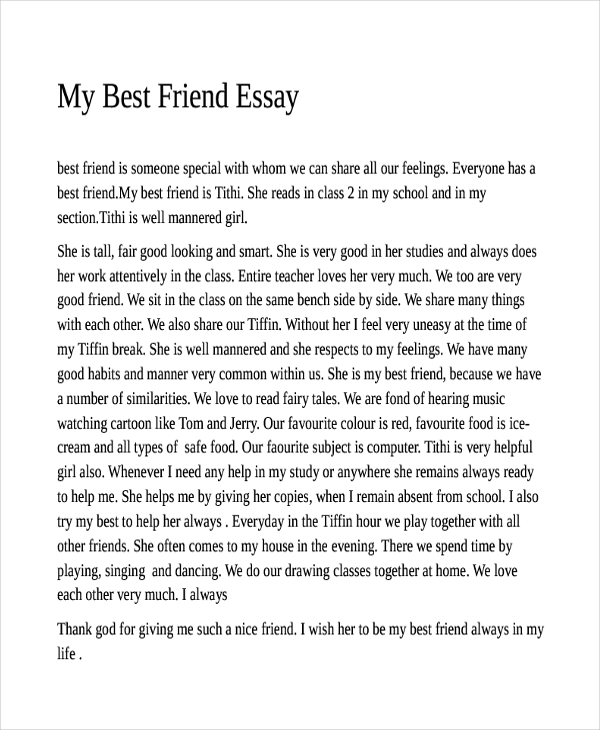
essssay.com
Narrative Descriptive Essay Example

preservearticles.com
Descriptive Essay Prewriting Example

fileserver.net-texts.com
Personal Descriptive Essay Example
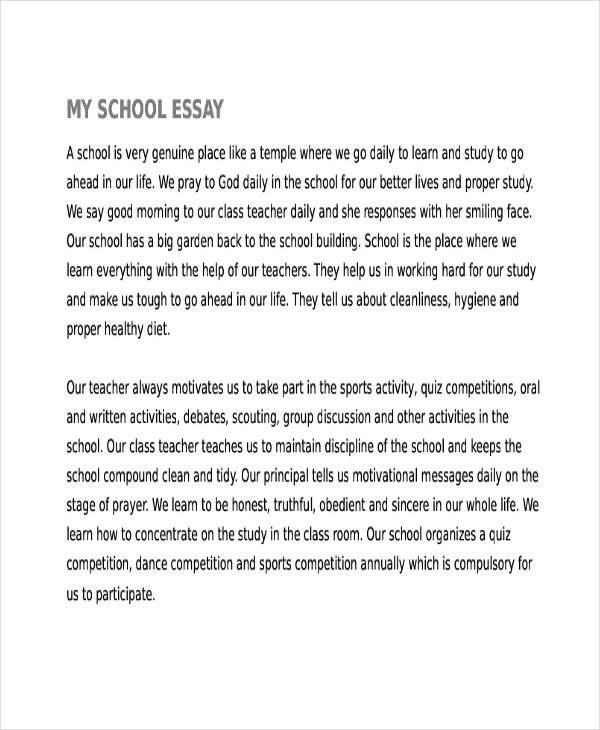
indiacelebrating.com
Descriptive Essay Characteristics Example

Descriptive Essay Description Guide Example
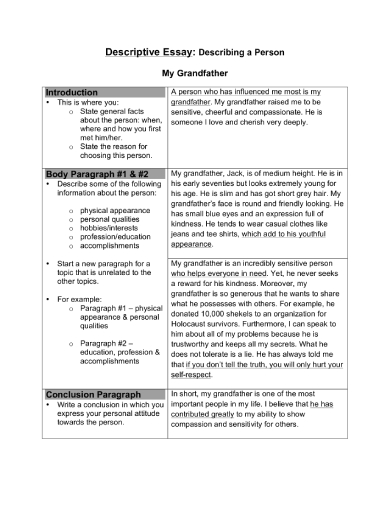
ortbinyaminaenglish.yolasite.com
Descriptive Essays about Places Example
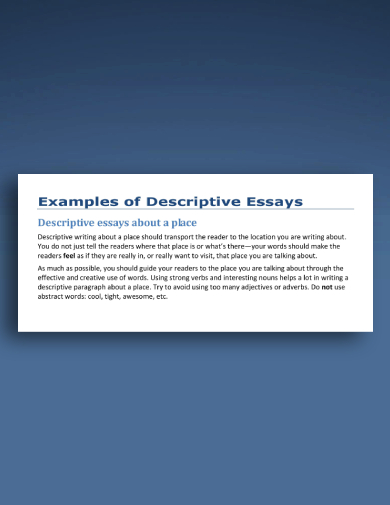
Excellent Descriptive Essay Example
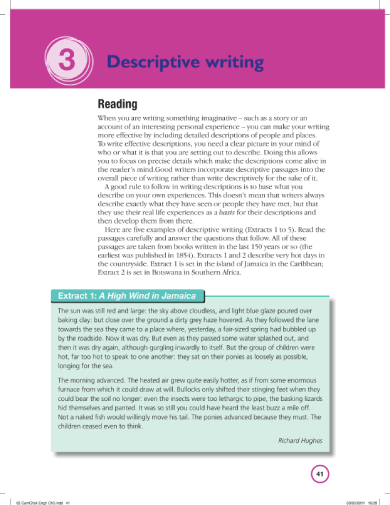
hoddereducation.co.uk
Descriptive Essay Writing Exercise Example

Educational Descriptive Essay Example

owll.massey.ac.nz
Spring Break Descriptive Essay Example
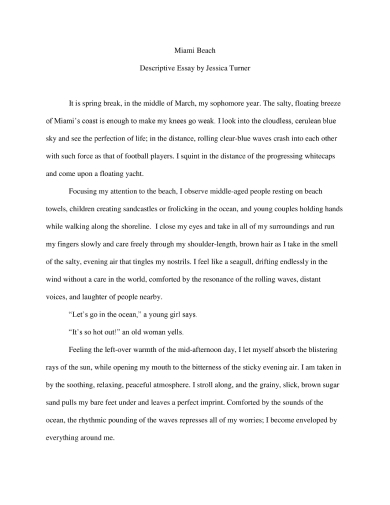
cheylin.com
Descriptive Essay Sentence Writing Example
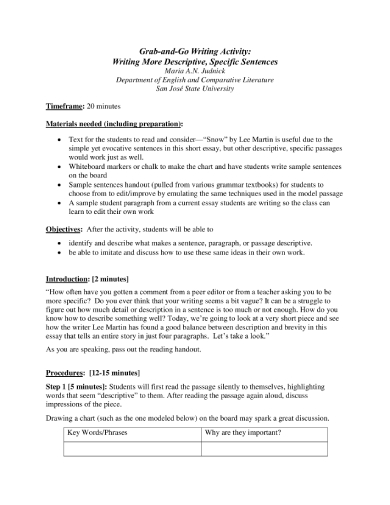
Descriptive Essay Paragraph Guidelines Example
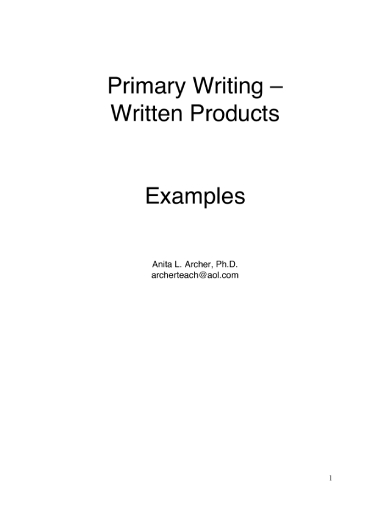
Stylish Descriptive Essay Rubric Example
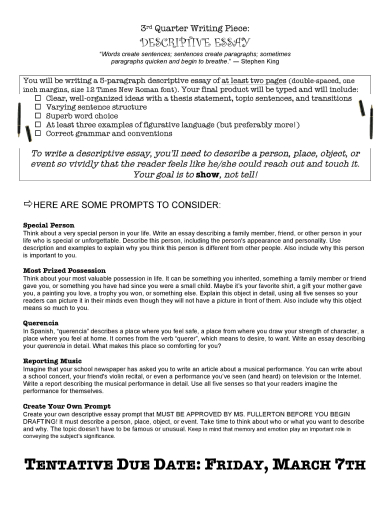
Descriptive Essay Writing Techniques Example
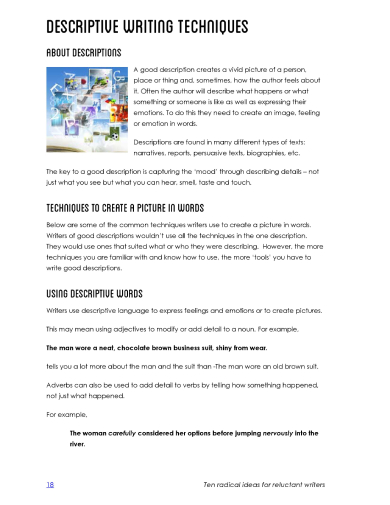
multifangled.com.au
Free Descriptive Essay Example
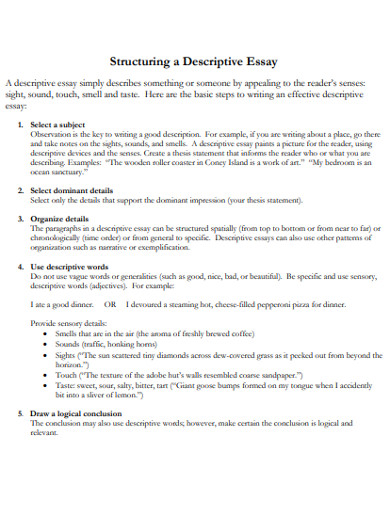
asc.weebly.com
Basic Descriptive Essay Example

hortonskids.org
Sample Descriptive Essay Example

essaytigers.com
Descriptive Essay in PDF Example
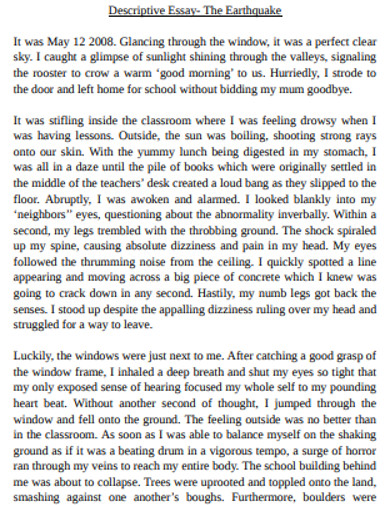
Printable Descriptive Essay Example
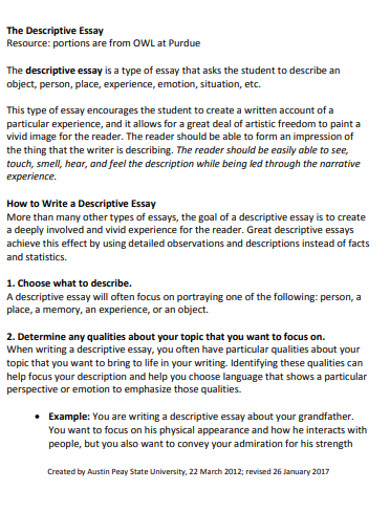
Direction Descriptive Essay Example
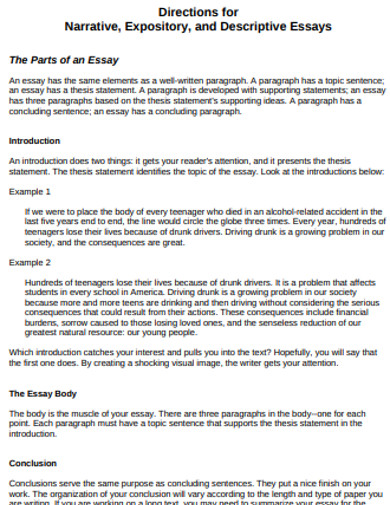
wba.aplusanywhere.com
Descriptive Essay Scoring Guide
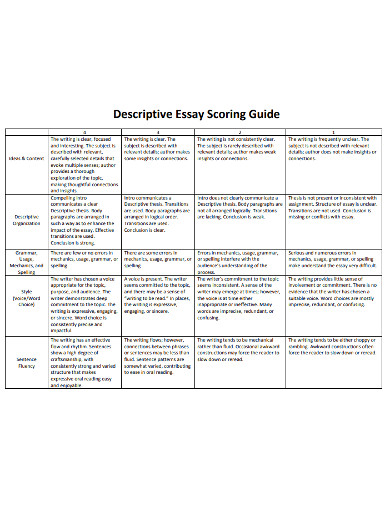
washoeschools.net
Professional Descriptive Essay

Descriptive Essay Format Example
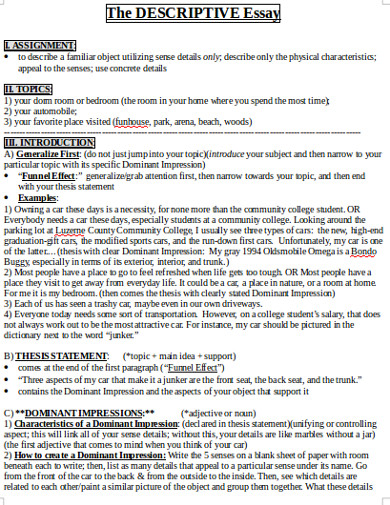
staff.kings.edu
Assignment Descriptive Essay Example

fd.valenciacollege.edu
What are the 4 types of essays?
An essay is an extended piece or composition that shows and supports a thesis or proposition. Essays help the expression of an author’s ideas in various ways. Before composing your own essay, it is important to identify its purpose first, and in doing that, distinguishing its type would be a great beginning. Correspondingly, here are the four different types of essays:
Narrative Essays: to tell
Taking it into its most basic sense, narrative essays are used if the author wants to tell a story about a real-life adventure. This type of essay is expressed in a particular point-of-view. Commonly, it is the author’s viewpoint that is being followed. Moreover, in writing your own short narrative essay , apply realistic emotions and appropriate sensory details to provide your readers with the full taste of your story. By doing this, you are not simply telling them but also engaging them in the story’s sequence and elements. It is also advisable to state verbs as vivid and as precise as possible. The thesis statement of a narrative essay is commonly found in the opening sentence or the last sentence of the introductory paragraph.
Descriptive Essays: to describe
You may confuse yourself between narrative and descriptive essays ; however, differentiating both is really easy. Rather than telling a story, a descriptive essay illustrates a specific topic such as a person, place, experience, emotion, event, etc. by means of words. You don’t simply state your experience in this type of essay; on top of that, you let your reader experience the same thing through your descriptions. In writing your own short descriptive essay , it is important to remember that you are not writing to tell but to show. Using sensory and vivid words is also recommended.
Expository Essays: to uncover and clarify
From its name itself, an expository essay is used to expose something on matters that are known to others. This type of essay is a genre of composition that aims to explain, illustrate, clarify or explicate a certain subject for the readers. Thus, an expository essay could include investigation and evaluation of ideas. This could be derived through comparison and contrast, definition, giving examples, assessment of cause and effect, etc. Moreover, in composing an expository essay, the author set his/her emotions aside for this type of essay is based on mere facts. The first point-of-view is not applied in this essay as well.
Persuasive Essays: to convince
If the expository essays talk about the facts then persuasive essays talk about arguments. The main purpose of a persuasive essay is to win over the trust of the reader to accept your viewpoint, opinion or proposition as the author. In writing a persuasive essay, your opinions should be supported by relevant facts and logical and sound reasoning. Though the essayist should lay all necessary details from both sides of the argument, he/she must comprehensibly explain why one side is correct or more favorable than the other.
Despite essays being categorized into four types, it is also important to know that an essay is not limited to one type only. In some cases, a narrative essay could also be mixed with a short descriptive essay or a short persuasive essay combined with an expository type. Nevertheless, identifying the purpose of your essay is vital before writing. However, if doing it challenges you, knowing these types is a great substitute.
What Is the Purpose of a Descriptive Essay?
Some people like to watch movies rather than to read books. This is because an actual image is easier to absorb than that on writing. This is why it’s important for a writer to pay close attention to detail. A descriptive essay conclusion should provide the reader with a mental picture of a given matter.
This is especially essential when writing pieces meant for a younger audience, as they have a more imaginative mind than the average adult. A writer must be creative when using imaginative language in order for the reader to properly comprehend what is being portrayed. To do so, the writer should also be knowledgeable about the topic. After all, you don’t want to give your readers the wrong interpretation .
How to Write a Descriptive Essay
A good descriptive essay comes from a knowledgeable and imaginative mind. Thus, in descriptive writing , it’s important for one to be specific on details. After seeing a few samples that we have shown earlier, here is a step-by-step guideline to help you in composing a descriptive essay worth reading.
1. Choose a topic.
If there is no given topic, it would be great to select one that you are knowledgeable and familiar with. Considering that your whole descriptive essay would revolve on this specific subject, choosing a topic that you recognize would keep everything simpler for you. By doing such, you can freely decide what words are the most appropriate to use; as a result, it will be easier for you to describe your topic. Furthermore, your reader could be meticulous and educated on your subject, so being knowledgeable about your own topic is wise prevention against bad impression.
2. Construct your thesis statement.
Alright, now that you have your own topic already, it is important to know what specific message you want your reader should focus on reading your whole essay. Thus, it is important to always provide a thesis statement , the umbrella sentence of all your ideas. Write this in one concise sentence in your introduction and conclusion. Often, a thesis statement is mentioned in the last sentence of your introductory paragraph.
3. Gather the necessary information and ideas.
Though you are already proficient in your topic, it is still recommendable to research about your specific subject. With this, you are not just gaining new information but also checking the correctness of your knowledge. It would also be great to expand your vocabulary, especially in adjectives and adverbs, since writing one of these involve loads of describing. Moreover, also focus on the sensory words that correspond to sight, smell, taste, sound, and touch of the given subject.
4. Create an outline.
Obtaining all of the significant details, crafting an essay outline for your work will allow you to arrange your contents in a rational and chronological order. Also, being educated with different formats in writing an essay would really make a great difference in your composition.
5. Proofread.
After writing your own descriptive essay, it might feel perfect already, but most of the time, it is not. Hence, read your entire work and review if there are any errors pertaining to your grammar and spelling. Furthermore, asking for help from a well-versed friend of yours to conduct a peer-review to your work would be extremely useful.
6. Finalize your composition.
The next thing to do after the editing is to finalize your descriptive essay to its finest version. Make sure that your essay follows a specific format, consisting of the proper parts of the essay .
Smart Tips for Writing a Descriptive Essay
The fundamentals of the descriptive writing procedures are now given to you; nevertheless, it would always be great to aim for something better. Now, here are some intelligent tips that would make your essay certainly more compelling.
Establish a connection with your writing.
The key to writing a good effective essay is to have the passion to write it; thus, in choosing your topic it would be great to have a familiar one or a subject that truly makes you curious. Let your interest be the seed of your fruitful composition.
Spend time to think.
In writing your own descriptive essay, let your brain do its job. Do not rush, give yourself an adequate amount of time to ponder on the necessary details that you should include and what approach you should apply. Provide yourself a clear plan of your descriptive essay writing. Moreover, look at your topic from different angles. This will allow you to take a closer look at every detail of your subject.
Apply the word vomit technique.
The word vomit technique or also called as “ free writing ” is the spontaneous use of words without considering any rules. This is a good technique in making a draft of your starting an essay . It allows your ideas to keep flowing without exerting much effort. Once this is done, you can pick out points that would go well with your essay.
Take a break before finalizing it.
Because right after writing your composition, your thought highly recognizes your word construction; thus, it does not really notice the errors and automatically treats them as correct pieces of your work. Allowing your mind to clear out for a while will make it easier for you to critic your own work. Furthermore, utilizing grammar-checking software is also a splendid move.
Text prompt
- Instructive
- Professional
Write a descriptive essay about a place you love to visit and what makes it special.
Describe in a descriptive essay your dream job and what it would be like to work there.
Darius Rucker on Drug Charges Arrest: ‘Somebody Wanted to Make an Example Out of Me’
- By Larisha Paul
Larisha Paul
When Darius Rucker discovered that a warrant was issued for his arrest in December 2023, he was caught off guard. The musician was taken into custody in February 2024 on charges of simple possession, casual exchange, and violation of registration law — one year after he was pulled over by police in Williamson County, Tennessee, for expired tags. “It shocked me,” Rucker told People in his first interview about the incident.
“My friends who were in the police department were like, ‘Have you pissed somebody off up here? Because this is crazy that they’re doing this a year later,’” he added. “But I think somebody wanted to make an example out of me, and they did. And I’m handling it with my lawyers, and paying the price, and we’ll move on with our lives.”
Bad Boy for Life: Sean Combs’ History of Violence
Cher wins royalty battle with sonny bono's widow, notorious b.i.g.'s mom: 'i want to slap the daylights out of sean combs', how a 4-hour video about disney’s failed ‘star wars’ hotel took over the internet.
Authorities had discovered marijuana and psilocin in the 58-year-old’s vehicle, though he remains unsure why the arrest warrant was issued nearly a full year following the stop. Rucker was released on a $10,500 bond on the same day of his arrest in February. “It sucks,” he said. “Fifty-seven years, never seen inside of a police car or jail, and I get busted for that.”
Additional insight into the musician’s life have been written into his first memoir, Life’s Too Short , out now. “This book is the story of my life as told through 23 songs that took me away, soaring, starting at ground level, living in a poor but happy home, never wanting for much more, enjoying what I had, even when times got tough, because I had my escape, my refuge, my music,” Rucker said in a statement earlier this year.
Megan Thee Stallion Lawyers Blast Cameraman's 'Outlandish' Harassment Claims
- By Nancy Dillon
Charly Bliss Will Hit the Road But Not Before 'Calling You Out'
- Blissful Tour
- By Tomás Mier
Carly Pearce Will Scale Back Tour Following Heart Condition Diagnosis
- Health Update
Michael McDonald's Smooth New Memoir: What We Learned From 'What a Fool Believes'
- DOOBIEST BROTHER
- By David Browne
Reggaeton-Shaking Dembow Beat Lawsuit to Proceed After Judge Denies Motions to Dismiss
- crimes and court
- By Daniel Kreps
Most Popular
Morgan spurlock, 'super size me' director, dies at 53, shannen doherty says 'little house on the prairie' co-star michael landon "spurred" her passion for acting, prince william & kate middleton are 'deeply upset' about the timing of the sussexes' brand relaunch, footage of bishop, 63, justifying marriage to 19-year-old congregant stirs debate, you might also like, variety announces ‘a night in the writers’ room’ lineup, the central saint martins 2024 b.a. graduate show got personal, with a protest against sponsor l’oréal, the best yoga mats for any practice, according to instructors, 2024 emmy predictions: outstanding documentary or nonfiction series, gerrit cole’s return nears as yankees starting pitching reigns.
Rolling Stone is a part of Penske Media Corporation. © 2024 Rolling Stone, LLC. All rights reserved.
Verify it's you
Please log in.

IMAGES
VIDEO
COMMENTS
Emotional Warrants - Aimed at stirring the reader's emotions. Authoritative Warrants - Rely on the credibility of the source or author. Analogical Warrants - Use analogies to draw parallels between concepts. Causal Warrants - Establish a cause-effect relationship. Generalization Warrants - Apply a general principle to a specific case.
1. Claim. What you want your readers to believe; the "point" you hope to persuade your reader of. 2. Evidence. What you will use to support the claim; your "proof"—often a direct or indirect quotation from a text, but sometimes a statistic or the like. 3. Warrant. A general principle that explains why you think your evidence is ...
What is the Toulmin Method? Developed by philosopher Stephen E. Toulmin, the Toulmin method is a style of argumentation that breaks arguments down into six component parts: claim, grounds, warrant, qualifier, rebuttal, and backing. In Toulmin's method, every argument begins with three fundamental parts: the claim, the grounds, and the warrant.
Warrants. Sometimes an argument needs further reinforcement through the use of what is known as a warrant, which is an underlying belief that connects a reason and the claim. Usually it is unnecessary to include warrants in an argument since the audience will generally also hold those beliefs, but there are occasions when they are critical to ...
Essays can present arguments about all kinds of different topics. For example: In a literary analysis essay, you might make an argument for a specific interpretation of a text; In a history essay, you might present an argument for the importance of a particular event; In a politics essay, you might argue for the validity of a certain political ...
Three argumentative methods —the Toulmin Method, Classical Method, and Rogerian Method— give guidance for how to organize the points in an argument. Note that these are only three of the most popular models for organizing an argument. Alternatives exist. Be sure to consult your instructor and/or defer to your assignment's directions if ...
Examples of warrants include appeals to authority, logical reasoning, empirical evidence, analogical reasoning, and cause-and-effect relationships. For instance, in a persuasive essay about climate change, a warrant might be the assumption that scientific consensus is a reliable indicator of truth.
warrant may need to be stated because it is a powerful part of the argument. When the warrant is stated, it is called an explicit warrant. Toulmin says that the weakest part of any argument is its weakest warrant. Remember that the warrant is the link between the data and the claim. If the warrant is not valid, the argument collapses.
The formulaic "five paragraph essay" that is often assigned in high school ("Scientific progress is good. Here are several reasons why scientific progress is good. ... Consider a case when an audience might not accept your argument unless it first accepts your warrant. Take, for example, the following discussion between a mother and her child.
A warrant is the assumption, common belief, or general principle that connects the claim to its support. In an essay, your warrant may not be stated at all, but you must know what it is in order to construct a solid argument. The warrant is the "So what?" part of your argument. Types of Warrants.
Updated on April 14, 2019. In the Toulmin model of argument, a warrant is a general rule indicating the relevance of a claim. A warrant may be explicit or implicit, but in either case, says David Hitchcock, a warrant is not the same as a premise. "Toulmin's grounds are premises in the traditional sense, propositions from which the claim is ...
Warrants are also an important part of academic writing. When writing an academic argument, it's important to use warrants to provide evidence and support for your claims. To do this, you'll want to find reliable sources of information that can provide evidence for your argument. This could include research studies, scholarly articles, and ...
From birthday cards to personal statements, college essays, or academic papers, strong writing is done with purpose. Structuring your writing around claims and evidence can give you the clarity to bring that purpose to the reader. ... For example, the warrant that bridges John's claim and evidence would be the idea that more car emissions and ...
Thoreau felt that each individual has the responsibility to understand and reject the "shams and delusions" that are too often accepted as truths. Thoreau demonstrated his misanthropy (hatred of human beings) in his essay and saw no choice but to abandon civilization. Notice how we could argue over the truth of the statements presented above.
Warrants determine whether the stated reasons support a given claim. Making claims is a practice done in situations that vary from everyday conversations to academic research papers. A warrant can be explicit or implicit. An explicit warrant is one that is stated; an implicit warrant is one that is unstated. You often see unstated warrants in ...
In persuasive writing you will make a claim at the beginning of your essay. Then the rest of your essay will be spent proving why your claim is correct and why your reader should agree with you. The warrant is the connection the reader can make between the claim and evidence. When a writer makes a claim and provides evidence, they will explain ...
Table 1 The Three Essential Components of Argument. Stephen Toulmin's model of argument posits the three essential elements of an argument are. Data (aka a Fact or Evidence); Claim; Warrant (which the writer, speaker, knowledge worker . . . may imply rather than explicitly state).; Toulmin's model presumes data, matters of fact and opinion, must be supplied as evidence to support a claim.
Warrants are assumptions that link claims to grounds. Warrants can be scientific laws, principles of historical interpretation, a law statute or psychological generalization about human behavior. Warrants may be implied or explicitly stated to support an argument. Source Kneupper Charles W Teaching Argument An Introduction to the Toulmin Model ...
It gets the reader thinking. It causes them to think of whether they agree or disagree, and it leaves them wanting to know on what you are basing your claim. The two key types of claims you will make in writing are thesis statements and topic sentences. A thesis statement is the central claim you make in your paper.
Example of the Toulmin Model Applied to an Argument. Let's break down the following argument: Schools should ban soda from their campuses to protect student health. Claim: Schools should ban soda from their campuses. Grounds: Banning soda would protect student health. Warrant 1: Poor diet leads to health problems in adolescents.
An Analysis Example: I think "genetic diversity", "future need for genetic resources" and "agricultural and economical value of genetic resources" are the warrants of this paper. We can easily see what the author values from her thesis and descriptions in this paper. For example, the vocabulary "genetic diversity" repeatedly ...
The warrant may be carefully explained and explicit or unspoken and implicit. The warrant answers the question, "Why does that data mean your claim is true?" For example, A hearing aid helps most people hear better. The warrant may be simple, and it may also be a longer argument with additional sub-elements including those described below.
Claim, Evidence and Warrant From Pixabay. Body paragraphs will often begin with a claim, then cite some evidence, then develop the warrant by reading the evidence through the claim; however, you should not regard these three elements as immovable parts of a rigid formula of 1+1+1=3. Claim, evidence and warrant should work together more organically than that.
1. Think of an important event. What you will be writing on your reflective essay is something that is rooted in your own personal experience or encounter of something. Think deep and concentrate. You may also see personal essay examples & samples. 2. Introduce your topic. In your introduction, write the concrete event or experience that you ...
A descriptive essay is a type of writing that aims to vividly describe a person, place, object, or event. In this type of essay, the writer uses sensory details such as sight, sound, smell, taste, and touch to create a clear and vivid image in the reader's mind. The goal of a descriptive essay is to evoke a strong emotional response or create ...
Jump to essay-4 Jones v. United States, 357 U.S. 493, 499 (1958). Jump to essay-5 McDonald v. United States, 335 U.S. 451, 456 (1948). In general, wi th regard to exceptions to th e warrant clause, conduct must be tested by th e reasonableness standard enunciated by th e first clause of th e Amendment, Terry v. Ohio, 392 U.S. 1, 20 (1968).
Four th Amendment:. Th e right of th e people to be secure in th eir persons, houses, papers, and effects, against unreasonable searches and seizures, shall not be violated, and no Warrants shall issue, but upon probable cause, supported by Oa th or affirmation, and particularly describing th e place to be searched, and th e persons or th ings to be seized.. Th e undoubted security imperatives ...
A search warrant gives the officer permission to conduct a limited search. Search warrants specify where law enforcement can search and items they can seize. When a Search Warrant Is Not Needed. In some instances, police do not need a warrant to arrest or search. For example, if an officer witnessed a suspect commit a crime, they can make an ...
In 2022 alone, the U.S. financial services industry filed around 26 million reports under the Bank Secrecy Act. Of those, 20.6 million were on transactions of $10,000 or more, with around 4.3 ...
Darius Rucker on Drug Charges Arrest: 'Somebody Wanted to Make an Example Out of Me'. The musician talked about the February incident — stemming from a traffic stop nearly a year earlier ...